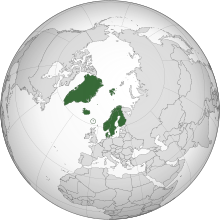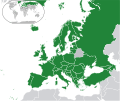Sweden
Sweden (/ˈswiː.dən/; Swedish: Sverige [ˈsvæ̌rjɛ] (![]()
![]()
Kingdom of Sweden | |
|---|---|
.svg.png) 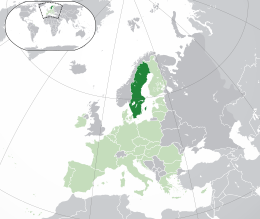 Location of Sweden (dark green) – in Europe (green & dark grey) | |
| Capital and largest city | Stockholm 59°21′N 18°4′E |
| Official languages | Swedish[c] |
| National minority languages | |
| Ethnic groups | No official statistics[d] |
| Religion (2017) | 67.2% Christianity —60.2% Church of Sweden[lower-alpha 1] —7.0% Other Christian 27.0% No religion 4.6% Islam 1.2% Other religions[7][8] |
| Demonym(s) |
|
| Government | Unitary parliamentary constitutional monarchy |
• Monarch | Carl XVI Gustaf |
| Andreas Norlén | |
| Stefan Löfven | |
| Legislature | Riksdag |
| History | |
• A unified Swedish kingdom established | By the early 12th century |
• Part of Kalmar Union | 1397–1523 |
• Part of Swedish-Norwegian Union | 4 November 1814 – August 1905[9] |
| 1 January 1995 | |
| Area | |
• Total | 450,295 km2 (173,860 sq mi) (55th) |
• Water (%) | 8.7 |
| Population | |
• 31 March 2020 estimate | |
• Density | 25/km2 (64.7/sq mi) (198th) |
| GDP (PPP) | 2019 estimate |
• Total | |
• Per capita | |
| GDP (nominal) | 2019 estimate |
• Total | |
• Per capita | |
| Gini (2019) | low |
| HDI (2018) | very high · 8th |
| Currency | Swedish krona (SEK) |
| Time zone | UTC+1 (CET) |
| UTC+2 (CEST) | |
| Date format | YYYY-MM-DD |
| Driving side | right[e] |
| Calling code | +46 |
| ISO 3166 code | SE |
| Internet TLD | .se[f] |
| |
Sweden is part of the geographical area of Fennoscandia. The climate is in general mild for its northerly latitude due to significant maritime influence. In spite of the high latitude, Sweden often has warm continental summers, being located in between the North Atlantic, the Baltic Sea and the vast Eurasian Russian landmass. The general climate and environment vary significantly from the south and north due to the vast latitudal difference, and much of Sweden has reliably cold and snowy winters. Southern Sweden is predominantly agricultural, while the north is heavily forested and includes a portion of the Scandinavian Mountains.
Germanic peoples have inhabited Sweden since prehistoric times, emerging into history as the Geats (Swedish Götar) and Swedes (Svear) and constituting the sea peoples known as the Norsemen. An independent Swedish state emerged during the early 12th century. After the Black Death in the middle of the 14th century killed about a third of the Scandinavian population,[22][23] the Hanseatic League threatened Scandinavia's culture, finances and languages. This led to the forming of the Scandinavian Kalmar Union in 1397,[24] which Sweden left in 1523. When Sweden became involved in the Thirty Years War on the Reformist side, an expansion of its territories began and eventually the Swedish Empire was formed. This became one of the great powers of Europe until the early 18th century. Swedish territories outside the Scandinavian Peninsula were gradually lost during the 18th and 19th centuries, ending with the annexation of present-day Finland by Russia in 1809. The last war in which Sweden was directly involved was in 1814, when Norway was militarily forced into a personal union, which peacefully dissolved in 1905. Since then, Sweden has been at peace, maintaining an official policy of neutrality in foreign affairs.[25] In 2014, Sweden celebrated 200 years of peace, breaking even Switzerland's record for peace.[26] Sweden was formally neutral through both world wars and the Cold War, albeit Sweden has since 2009 openly moved towards cooperation with NATO.
Sweden is a constitutional monarchy and a parliamentary democracy, with legislative power vested in the 349-member unicameral Riksdag. It is a unitary state, currently divided into 21 counties and 290 municipalities. Sweden maintains a Nordic social welfare system that provides universal health care and tertiary education for its citizens. It has the world's eleventh-highest per capita income and ranks very highly in quality of life, health, education, protection of civil liberties, economic competitiveness, income equality, gender equality, prosperity and human development.[27][28][29] Sweden joined the European Union on 1 January 1995, but has rejected NATO membership, as well as Eurozone membership following a referendum. It is also a member of the United Nations, the Nordic Council, the Council of Europe, the World Trade Organization and the Organisation for Economic Co-operation and Development (OECD).
Etymology
The word Sweden is derived from 17th century Middle Dutch and Middle Low German. In Old English the country was named Swéoland and Swíoríce (Old Norse Svíaríki). Anglo-Norman of the 12th and 13th centuries used Suane, Swane (with the adjective as Suaneis). In Scots Swane, Swaine, appears in the 16th century. Early Modern English used Swedeland.[30]
The Swedish name Sverige (a compound of the words Svea and rike, with lenition of the consonant [k], first recorded in the cognate Swēorice in Beowulf)[31] literally means "realm of the Swedes", excluding the Geats in Götaland.
Variations of the name Sweden are used in most languages, with the exception of Danish and Norwegian using Sverige, Faroese Svøríki, Icelandic Svíþjóð, and the more notable exception of some Finnic languages where Ruotsi (Finnish) and Rootsi (Estonian) are used, names commonly considered as referring to the people from the coastal areas of Roslagen, Uppland, who were known as the Rus', and through them etymologically related to the English name for Russia.
The etymology of Swedes, and thus Sweden, is generally not agreed upon but may derive from Proto-Germanic *Swihoniz meaning "one's own",[32] referring to one's own Germanic tribe.
History
Prehistory
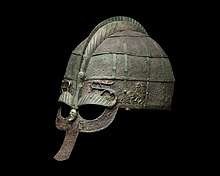
Sweden's prehistory begins in the Allerød oscillation, a warm period around 12,000 BC, with Late Palaeolithic reindeer-hunting camps of the Bromme culture at the edge of the ice in what is now the country's southernmost province, Scania. This period was characterized by small bands of hunter-gatherer-fishers using flint technology.
Sweden is first described in a written source in Germania by Tacitus in 98 AD. In Germania 44 and 45 he mentions the Swedes (Suiones) as a powerful tribe (distinguished not merely for their arms and men, but for their powerful fleets) with ships that had a prow at each end (longships). Which kings (kuningaz) ruled these Suiones is unknown, but Norse mythology presents a long line of legendary and semi-legendary kings going back to the last centuries BC. As for literacy in Sweden itself, the runic script was in use among the south Scandinavian elite by at least the 2nd century AD, but all that has come down to the present from the Roman Period is curt inscriptions on artefacts, mainly of male names, demonstrating that the people of south Scandinavia spoke Proto-Norse at the time, a language ancestral to Swedish and other North Germanic languages.
In the 6th century, Jordanes names two tribes living in Scandza, both of which are now considered to be synonymous with the Swedes: the Suetidi and Suehans. Suetidi is considered to be the Latin form of Svíþjóð, the Old Norse name for the Swedes. Jordanes describes the Suetidi and Dani as being of the same stock and the tallest of people. He later mentions other Scandinavian tribes as being of a same stature. The Suehans were known to the Roman world as suppliers of black fox skins and, according to Jordanes, had very fine horses, similar to those of the Thyringi of Germania (alia vero gens ibi moratur Suehans, quae velud Thyringi equis utuntur eximiis). The Icelandic historian Snorri Sturluson also wrote that the Swedish king Adils (Eadgils) had the finest horses of his day.
The Vikings
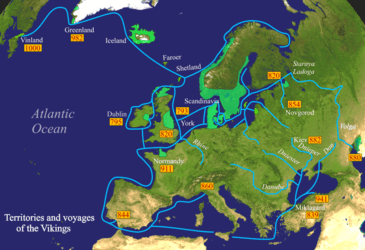
The Swedish Viking Age lasted roughly from the 8th century to the 11th century. It is believed that Swedish Vikings and Gutar mainly travelled east and south, going to Finland, the Baltic countries, Russia, Belarus, Ukraine, the Black Sea and even as far as Baghdad. Their routes passed through the Dnieper south to Constantinople, on which they carried out numerous raids. The Byzantine Emperor Theophilos noticed their great skills in war, and invited them to serve as his personal bodyguard, known as the Varangian Guard. The Swedish Vikings, called Rus are believed to be the founding fathers of Kievan Rus'. The Arab traveller Ibn Fadlan described these Vikings as follows:
I have seen the Rus as they came on their merchant journeys and encamped by the Itil. I have never seen more perfect physical specimens, tall as date palms, blond and ruddy; they wear neither tunics nor caftans, but the men wear a garment which covers one side of the body and leaves a hand free. Each man has an axe, a sword, and a knife, and keeps each by him at all times. The swords are broad and grooved, of Frankish sort.[33]
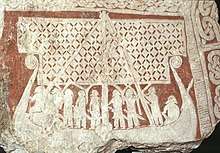
The actions of these Swedish Vikings are commemorated on many runestones in Sweden, such as the Greece runestones and the Varangian runestones. There was also considerable participation in expeditions westwards, which are commemorated on stones such as the England runestones. The last major Swedish Viking expedition appears to have been the ill-fated expedition of Ingvar the Far-Travelled to Serkland, the region south-east of the Caspian Sea. Its members are commemorated on the Ingvar runestones, none of which mentions any survivor. What happened to the crew is unknown, but it is believed that they died of sickness.
The Kingdom of Sweden
It is not known when and how the kingdom of Sweden was born, but the list of Swedish monarchs is drawn from the first kings known to have ruled both Svealand (Sweden) and Götaland (Gothia) as one province, beginning with Eric the Victorious. Sweden and Gothia were two separate nations long before that and since antiquity. It is not known how long they existed: the epic poem Beowulf describes semi-legendary Swedish-Geatish wars in the 6th century. Götaland in this sense mainly includes the provinces of Östergötland (East Gothia) and Västergötland (West Gothia). The island of Gotland was disputed by other than Swedes, at this time (Danish, Hanseatic, and Gotland-domestic). Småland was at that time of little interest to anyone due to the deep pine forests, and only the city of Kalmar with its castle was of importance. The south-west parts of the Scandinavian peninsula consisted of three Danish provinces (Scania, Blekinge and Halland). North of Halland, Denmark had a direct border to Norway and its province Bohuslän. But there were Swedish settlements along the southern coastline of Norrland.
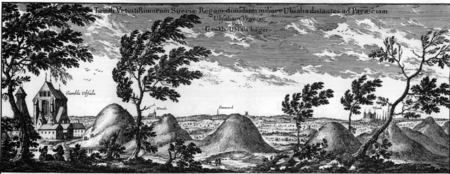
During the early stages of the Scandinavian Viking Age, Ystad in the Danish province Scania and Paviken on Gotland were flourishing centres of trade, but they were not parts of the early Swedish Kingdom. Remains of what is believed to have been a large market dating from 600 to 700 AD have been found in Ystad.[34] In Paviken, an important centre of trade in the Baltic region during the 9th and 10th century, remains have been found of a large Viking Age harbour with shipbuilding yards and handicraft industries. Between 800 and 1000, trade brought an abundance of silver to Gotland, and according to some scholars, the Gotlanders of this era hoarded more silver than the rest of the population of Scandinavia combined.[34]
St Ansgar is usually credited with introducing Christianity in 829, but the new religion did not begin to fully replace paganism until the 12th century. During the 11th century, Christianity became the prevalent religion, and from 1050 Sweden is counted as a Christian nation. The period between 1100 and 1400 was characterised by internal power struggles and competition among the Nordic kingdoms. In the years 1150–1293 according to the legend of Eric IX and the Eric Chronicles Swedish kings made a first, second and third crusade to pagan Finland against Finns, Tavastians and Karelians and started conflicts with the Rus' who no longer had any connection with Sweden.[35] The Swedish colonisation of the coastal areas of Finland started also during the 12th and 13th century.[36][37] In the 14th century, the Swedish colonisation of coastal areas of Finland began to be more organised and in the end of the century several of the coastal areas of Finland were inhabited mostly by Swedes.[38]
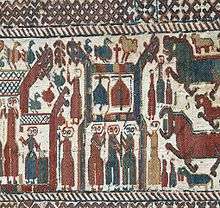
Except for the provinces of Scania, Blekinge and Halland in the south-west of the Scandinavian peninsula, which were parts of the Kingdom of Denmark during this time, feudalism never developed in Sweden as it did in the rest of Europe.[39] The peasantry therefore remained largely a class of free farmers throughout most of Swedish history. Slavery (also called thralldom) was not common in Sweden,[40] and what slavery there was tended to be driven out of existence thanks to the spread of Christianity as well as to the difficulty to obtain slaves from the lands east of the Baltic Sea, and by the development of cities before the 16th century.[41] Indeed, both slavery and serfdom were abolished altogether by a decree of King Magnus IV in 1335. Former slaves tended to be absorbed into the peasantry, and some became labourers in the towns. Still, Sweden remained a poor and economically backward country in which barter was the primary means of exchange. For instance, the farmers of the province of Dalsland would transport their butter to the mining districts of Sweden and exchange it there for iron, which they would then take to the coast and trade for fish, which they consumed, while the iron would be shipped abroad.[42]
In the middle of the 14th century, Sweden was struck by the Black Death.[43] The population of Sweden and most of Europe was seriously decimated. The population (at same territory) did not reach the numbers of the year 1348 again until the beginning of the 19th century. One third of the population died in the triennium of 1349–1351. During this period, the Swedish cities began to acquire greater rights and were strongly influenced by German merchants of the Hanseatic League, active especially at Visby. In 1319, Sweden and Norway were united under King Magnus Eriksson, and in 1397 Queen Margaret I of Denmark effected the personal union of Sweden, Norway, and Denmark through the Kalmar Union. However, Margaret's successors, whose rule was also centred in Denmark, were unable to control the Swedish nobility.
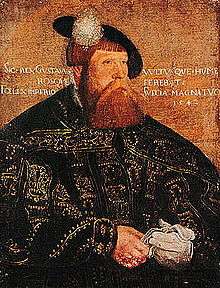
Many times the Swedish crown was inherited by children kings over the course of the kingdom's existence; consequently real power was held for long periods by regents (notably those of the Sture family) chosen by the Swedish parliament. King Christian II of Denmark, who asserted his claim to Sweden by force of arms, ordered a massacre of Swedish nobles in Stockholm in 1520. This came to be known as the "Stockholm blood bath" and stirred the Swedish nobility to new resistance and, on 6 June (now Sweden's national holiday) in 1523, they made Gustav Vasa their king.[44] This is sometimes considered as the foundation of modern Sweden. Shortly afterwards the new king rejected Catholicism and led Sweden into the Protestant Reformation.
The Hanseatic League had been officially formed at Lübeck on the Baltic coast of Northern Germany in 1356. The League sought civil and commercial privileges from the princes and royalty of the countries and cities along the coasts of the Baltic Sea.[45] In exchange, they offered a certain amount of protection to the joining cities. Having their own navy, the Hansa were able to sweep the Baltic Sea free of pirates.[46] The privileges obtained by the Hansa included assurances that only Hansa citizens would be allowed to trade from the ports where they were located. They sought agreement to be free of all customs and taxes. With these concessions, Lübeck merchants flocked to Stockholm, where they soon came to dominate the city's economic life and made the port city of Stockholm into the leading commercial and industrial city of Sweden.[47] Under the Hanseatic trade, two-thirds of Stockholm's imports consisted of textiles, while the remaining third was salt. The main exports from Sweden were iron and copper.[47]
However, the Swedes began to resent the monopoly trading position of the Hansa (mostly consisting of German citizens), and to resent the income they felt they lost to the Hansa. Consequently, when Gustav Vasa or Gustav I broke the monopoly power of the Hanseatic League he was regarded as a hero by the Swedish people.[48] History now views Gustav I as the father of the modern Swedish nation. The foundations laid by Gustav would take time to develop. Furthermore, when Sweden did develop, freed itself from the Hanseatic League, and entered its golden era, the fact that the peasantry had traditionally been free meant that more of the economic benefits flowed back to them rather than going to a feudal landowning class.[49]
The end of the 16th century was marked by a final phase of rivalry between the remaining Catholics and the new Protestant communities. In 1592, Gustav Vasa's Catholic grandson and king of Poland, Sigismund, ascended the Swedish throne.[50] He pursued to strengthen Rome's influence by initiating Counter-Reformation and created a dual monarchy, which temporarily became known as the Polish-Swedish Union. His despotic rule, strongly characterized by intolerance towards the Protestants, sparked a civil war that plunged Sweden into poverty.[51] In opposition, Sigismund's uncle and successor, Charles Vasa, summoned the Uppsala Synod in 1593 which officially confirmed the modern Church of Sweden as Lutheran. Following his deposition in 1599, Sigismund attempted to reclaim the throne at every expense and hostilities between Poland and Sweden continued for the next one hundred years.[52]
Swedish Empire
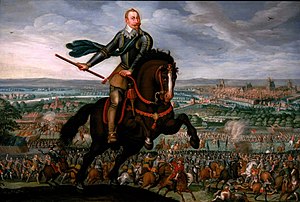
During the 17th century, Sweden emerged as a European great power. Before the emergence of the Swedish Empire, Sweden was a poor and scarcely populated country on the fringe of European civilisation, with no significant power or reputation. Sweden rose to prominence on a continental scale during the tenure of king Gustavus Adolphus, seizing territories from Russia and Poland–Lithuania in multiple conflicts, including the Thirty Years' War.[53]
During the Thirty Years' War, Sweden conquered approximately half of the Holy Roman states and defeated the Imperial army at the Battle of Breitenfeld in 1631.[54] Gustav Adolphus planned to become the new Holy Roman Emperor, ruling over a united Scandinavia and the Holy Roman states, but he died at the Battle of Lützen in 1632. After the Battle of Nördlingen in 1634, Sweden's only significant military defeat of the war, pro-Swedish sentiment among the German states faded.[54] These German provinces excluded themselves from Swedish power one by one, leaving Sweden with only a few northern German territories: Swedish Pomerania, Bremen-Verden and Wismar. From 1643 to 1645, during the last years of the war, Sweden and Denmark-Norway fought the Torstenson War. The result of that conflict and the conclusion of the Thirty Years' War helped establish postwar Sweden as a major force in Europe.[54]
_en2.png)
In the middle of the 17th century Sweden was the third-largest country in Europe by land area, surpassed by only Russia and Spain. Sweden reached its largest territorial extent under the rule of Charles X after the treaty of Roskilde in 1658, following Charles X's risky but successful crossing of the Danish Belts.[55][56] The foundation of Sweden's success during this period is credited to Gustav I's major changes to the Swedish economy in the 16th century, and his introduction of Protestantism.[57] In the 17th century, Sweden was engaged in many wars, for example with the Polish–Lithuanian Commonwealth, with both sides competing for territories of today's Baltic states, with the disastrous Battle of Kircholm being one of the highlights.[58] One-third of the Finnish population died in the devastating Great Famine of 1695–1697 that struck the country.[59] Famine also hit Sweden, killing roughly 10% of Sweden's population.[60]
The Swedes conducted a series of invasions into the Polish–Lithuanian Commonwealth, known as the Deluge.[61] After more than half a century of almost constant warfare, the Swedish economy had deteriorated. It became the lifetime task of Charles X's son, Charles XI, to rebuild the economy and refit the army.[62] His legacy to his son, the coming ruler of Sweden, Charles XII, was one of the finest arsenals in the world, a large standing army and a great fleet.[63] Sweden's largest threat at this time, Russia, had a larger army but was far behind in both equipment and training.[64]
After the Battle of Narva in 1700, one of the first battles of the Great Northern War, the Russian army was so severely devastated that Sweden had an open chance to invade Russia.[65] However, Charles XII did not pursue the Russian army, instead turning against Poland–Lithuania and defeating the Polish king, Augustus II the Strong, and his Saxon allies at the Battle of Kliszów in 1702.[66] This gave Russia time to rebuild and modernise its army.
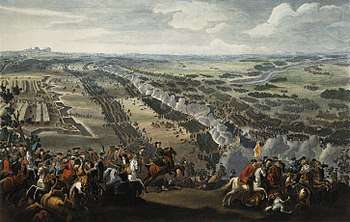
After the success of invading Poland, Charles XII decided to make an attempt at invading Russia, but this ended in a decisive Russian victory at the Battle of Poltava in 1709.[67] After a long march exposed to Cossack raids, the Russian Tsar Peter the Great's scorched-earth techniques and the extremely cold winter of 1709, the Swedes stood weakened with a shattered morale and were enormously outnumbered against the Russian army at Poltava.[68] The defeat meant the beginning of the end for the Swedish Empire. In addition, the plague raging in East Central Europe devastated the Swedish dominions and reached Central Sweden in 1710.[69][70] Charles XII attempted to invade Norway in 1716, but he was shot dead at Fredriksten fortress in 1718.[71] The Swedes were not militarily defeated at Fredriksten, but the whole structure and organisation of the campaign fell apart with the king's death, and the army withdrew.
Forced to cede large areas of land in the Treaty of Nystad in 1721, Sweden also lost its place as an empire and as the dominant state on the Baltic Sea.[72] With Sweden's lost influence, Russia emerged as an empire and became one of Europe's dominant nations. As the war finally ended in 1721, Sweden had lost an estimated 200,000 men, 150,000 of those from the area of present-day Sweden and 50,000 from the Finnish part of Sweden.[73]
In the 18th century, Sweden did not have enough resources to maintain its territories outside Scandinavia, and most of them were lost, culminating with the loss in 1809 of eastern Sweden to Russia, which became the highly autonomous Grand Principality of Finland in Imperial Russia.[74]
In interest of re-establishing Swedish dominance in the Baltic Sea, Sweden allied itself against its traditional ally and benefactor, France, in the Napoleonic Wars. However, in 1810, a French Marshal was chosen the heir presumptive to the decrepit Charles XIII; in 1818, he established the House of Bernadotte. Sweden's role in the Battle of Leipzig gave it the authority to force Denmark–Norway, an ally of France, to cede Norway to the King of Sweden on 14 January 1814 in exchange for the northern German provinces, at the Treaty of Kiel.[75] The Norwegian attempts to keep their status as a sovereign state were rejected by the Swedish king, Charles XIII. He launched a military campaign against Norway on 27 July 1814, ending in the Convention of Moss, which forced Norway into a personal union with Sweden under the Swedish crown, which lasted until 1905.[76] The 1814 campaign was the last time Sweden was at war.[77]
Modern history
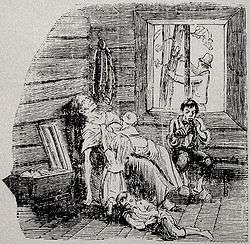
The Swedish East India Company, Ostindiska Kompaniet, began in 1731. The obvious choice of home port was Gothenburg at Sweden's west coast, the mouth of Göta älv river is very wide and has the county's largest and best harbour for high-seas journeys. The trade continued into the 19th century, and caused the little town to become Sweden's second city.[78] There was a significant population increase during the 18th and 19th centuries, which the writer Esaias Tegnér in 1833 attributed to "the peace, the smallpox vaccine, and the potatoes".[79] Between 1750 and 1850, the population in Sweden doubled. According to some scholars, mass emigration to America became the only way to prevent famine and rebellion; over 1% of the population emigrated annually during the 1880s.[80] Nevertheless, Sweden remained poor, retaining a nearly entirely agricultural economy even as Denmark and Western European countries began to industrialise.[80][81]
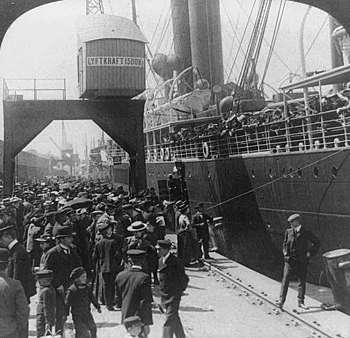
Many looked towards America for a better life during this time. It is thought that between 1850 and 1910 more than one million Swedes moved to the United States.[82] In the early 20th century, more Swedes lived in Chicago than in Gothenburg (Sweden's second largest city).[83] Most Swedish immigrants moved to the Midwestern United States, with a large population in Minnesota, with a few others moving to other parts of the United States and Canada.
Despite the slow rate of industrialisation into the 19th century, many important changes were taking place in the agrarian economy due to constant innovations and a rapid population growth.[84] These innovations included government-sponsored programmes of enclosure, aggressive exploitation of agricultural lands, and the introduction of new crops such as the potato.[84] Because the Swedish peasantry had never been enserfed as elsewhere in Europe,[85] the Swedish farming culture began to take on a critical role in Swedish politics, which has continued through modern times with modern Agrarian party (now called the Centre Party).[86] Between 1870 and 1914, Sweden began developing the industrialised economy that exists today.[87]
Strong grassroots movements sprang up in Sweden during the latter half of the 19th century (trade unions, temperance groups, and independent religious groups), creating a strong foundation of democratic principles. In 1889 The Swedish Social Democratic Party was founded. These movements precipitated Sweden's migration into a modern parliamentary democracy, achieved by the time of World War I. As the Industrial Revolution progressed during the 20th century, people gradually moved into cities to work in factories and became involved in socialist unions. A communist revolution was avoided in 1917, following the re-introduction of parliamentarism, and the country was democratised.
World War I and World War II
Sweden was officially neutral during World War I, although, under German pressure, they did take steps which were detrimental to the Allied powers including mining the Øresund channel, thus closing it to Allied shipping, and allowing the Germans to use Swedish facilities and the Swedish cipher to transmit secret messages to their overseas embassies.[88] Sweden also allowed volunteers to fight for the White Guards alongside the Germans against the Red Guards and Russians in the Finnish Civil War, and briefly occupied the Åland Islands in co-operation with Germany.
As in the First World War, Sweden remained officially neutral during World War II, although its neutrality during World War II has been disputed.[89][90] Sweden was under German influence for much of the war, as ties to the rest of the world were cut off through blockades.[89] The Swedish government felt that it was in no position to openly contest Germany,[91] and therefore made some concessions.[92] Sweden also supplied steel and machined parts to Germany throughout the war. The Swedish government unofficially supported Finland in the Winter War and the Continuation War by allowing volunteers and materiel to be shipped to Finland. However, Sweden supported Norwegian resistance against Germany, and in 1943 helped rescue Danish Jews from deportation to Nazi concentration camps.
During the last year of the war, Sweden began to play a role in humanitarian efforts, and many refugees, among them several thousand Jews from Nazi-occupied Europe, were rescued thanks to the Swedish rescue missions to internment camps and partly because Sweden served as a haven for refugees, primarily from the Nordic countries and the Baltic states.[91] The Swedish diplomat Raoul Wallenberg and his colleagues ensured the safety of tens of thousands of Hungarian Jews.[93] Nevertheless, both Swedes and others have argued that Sweden could have done more to oppose the Nazis' war efforts, even if it meant increasing the risk of occupation.[91]
Post-war era
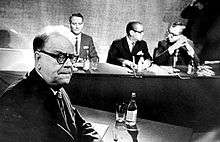
Sweden was officially a neutral country and remained outside NATO and Warsaw Pact membership during the Cold War, but privately Sweden's leadership had strong ties with the United States and other western governments. Following the war, Sweden took advantage of an intact industrial base, social stability and its natural resources to expand its industry to supply the rebuilding of Europe.[94] Sweden received aid under the Marshall Plan and participated in the OECD. During most of the post-war era, the country was governed by the Swedish Social Democratic Party largely in co-operation with trade unions and industry. The government actively pursued an internationally competitive manufacturing sector of primarily large corporations.[95]
Sweden was one of the founding states of the European Free Trade Area (EFTA). During the 1960s the EFTA countries were often referred to as the Outer Seven, as opposed to the Inner Six of the then-European Economic Community (EEC).[96]
Sweden, like many industrialised countries, entered a period of economic decline and upheaval following the oil embargoes of 1973–74 and 1978–79.[97] In the 1980s several key Swedish industries were significantly restructured. Shipbuilding was discontinued, wood pulp was integrated into modernised paper production, the steel industry was concentrated and specialised, and mechanical engineering was robotised.[98]
Between 1970 and 1990, the overall tax burden rose by over 10%, and the growth was low compared with other countries in Western Europe. Eventually the government began to spend over half of the country's gross domestic product. Swedish GDP per capita ranking declined during this time.[95]
Recent history
.jpg)
A bursting real estate bubble caused by inadequate controls on lending combined with an international recession and a policy switch from anti-unemployment policies to anti-inflationary policies resulted in a fiscal crisis in the early 1990s.[99] Sweden's GDP declined by around 5%. In 1992, a run on the currency caused the central bank to briefly increase interest rates to 500%.[100][101]
The response of the government was to cut spending and institute a multitude of reforms to improve Sweden's competitiveness, among them reducing the welfare state and privatising public services and goods. Much of the political establishment promoted EU membership, and a referendum passed with 52.3% in favour of joining the EU on 13 November 1994. Sweden joined the European Union on 1 January 1995. In a 2003 referendum the Swedish electorate voted against the country joining the Euro currency. In 2006 Sweden got its first majority government for decades as the centre-right Alliance defeated the incumbent Social Democrat government. Following the rapid growth of support for the anti-immigration Sweden Democrats, and their entrance to the Riksdag in 2010, the Alliance became a minority cabinet.
Sweden remains non-aligned militarily, although it participates in some joint military exercises with NATO and some other countries, in addition to extensive co-operation with other European countries in the area of defence technology and defence industry. Among others, Swedish companies export weapons that were used by the American military in Iraq.[102] Sweden also has a long history of participating in international military operations, including Afghanistan, where Swedish troops are under NATO command, and in EU-sponsored peacekeeping operations in Kosovo, Bosnia and Herzegovina, and Cyprus. Sweden also participated in enforcing a UN mandated no-fly zone over Libya during the Arab Spring. Sweden held the chair of the European Union from 1 July to 31 December 2009.
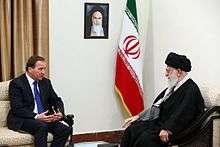
In recent decades Sweden has become a more culturally diverse nation due to significant immigration; in 2013 it was estimated that 15 per cent of the population was foreign-born, and an additional 5 per cent of the population were born to two immigrant parents. The influx of immigrants has brought new social challenges. Violent incidents have periodically occurred[103][104] including the 2013 Stockholm riots which broke out following the police shooting of an elderly Portuguese immigrant.[105] In response to these violent events, the anti-immigration opposition party, the Sweden Democrats, promoted their anti-immigration policies, while the left-wing opposition blamed growing inequality caused by the centre-right government's socioeconomic policies.[106]
In 2014, Stefan Löfven (Social Democrats) won the General Election and became the new Swedish Prime Minister. The Sweden Democrats held the balance of power and voted the government's budget down in the Riksdag, but due to agreements between the government and the Alliance, the government was able to hang onto power.[107] Sweden was heavily affected by the 2015 European migrant crisis, eventually forcing the government to tighten regulations of entry to the country, as Sweden received thousands of asylum seekers and migrants predominantly from Africa and the Middle East per week in autumn, overwhelming existing structures.[108] Some of the asylum restrictions were relaxed again later.[109]
The 2018 general election saw the Red-greens lose seats to the right-wing Sweden Democrats and to the centre-right parties of the former Alliance. Despite holding only 33% of the seats in the Riksdag, the Social Democrats and the Greens managed to form a minority government in January 2019, relying on supply and confidence from the Centre Party, Liberals and the Left Party.
Geography
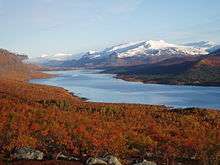
Situated in Northern Europe, Sweden lies west of the Baltic Sea and Gulf of Bothnia, providing a long coastline, and forms the eastern part of the Scandinavian Peninsula. To the west is the Scandinavian mountain chain (Skanderna), a range that separates Sweden from Norway. Finland is located to its north-east. It has maritime borders with Denmark, Germany, Poland, Russia, Lithuania, Latvia and Estonia, and it is also linked to Denmark (south-west) by the Öresund Bridge. Its border with Norway (1,619 km long) is the longest uninterrupted border within Europe.
Sweden lies between latitudes 55° and 70° N, and mostly between longitudes 11° and 25° E (part of Stora Drammen island is just west of 11°).
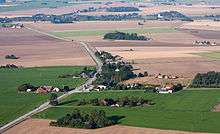
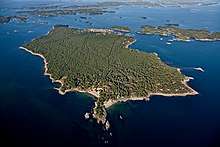
At 449,964 km2 (173,732 sq mi), Sweden is the 55th-largest country in the world,[110] the 4th-largest country entirely in Europe, and the largest in Northern Europe. The lowest elevation in Sweden is in the bay of Lake Hammarsjön, near Kristianstad, at −2.41 m (−7.91 ft) below sea level. The highest point is Kebnekaise at 2,111 m (6,926 ft) above sea level.
Sweden has 25 provinces or landskap, based on culture, geography and history. While these provinces serve no political or administrative purpose, they play an important role in people's self-identity. The provinces are usually grouped together in three large lands, parts, the northern Norrland, the central Svealand and southern Götaland. The sparsely populated Norrland encompasses almost 60% of the country. Sweden also has the Vindelfjällen Nature Reserve, one of the largest protected areas in Europe, totaling 562,772 ha (approx. 5,628 km2).
About 15% of Sweden lies north of the Arctic Circle. Southern Sweden is predominantly agricultural, with increasing forest coverage northward. Around 65% of Sweden's total land area is covered with forests. The highest population density is in the Öresund Region in southern Sweden, along the western coast up to central Bohuslän, and in the valley of lake Mälaren and Stockholm. Gotland and Öland are Sweden's largest islands; Vänern and Vättern are its largest lakes. Vänern is the third largest in Europe, after Lake Ladoga and Lake Onega in Russia. Combined with the third- and fourth-largest lakes Mälaren and Hjälmaren, these lakes take up a significant part of the southern Sweden's area. Sweden's extensive waterway availability throughout the south was exploited with the building of the Göta Canal in the 19th century, shortening the potential distance between the Baltic Sea south of Norrköping and Gothenburg by using the lake and river network to facilitate the canal[111].
Climate
Most of Sweden has a temperate climate, despite its northern latitude, with largely four distinct seasons and mild temperatures throughout the year. The winter in the far south is usually weak and is manifested only through some shorter periods with snow and sub-zero temperatures, autumn may well turn into spring there, without a distinct period of winter. The country can be divided into three types of climate: the southernmost part has an oceanic climate, the central part has a humid continental climate and the northernmost part has a subarctic climate. However, Sweden is much warmer and drier than other places at a similar latitude, and even somewhat farther south, mainly because of the combination of the Gulf Stream[112][113] and the general west wind drift, caused by the direction of planet Earth's rotation. Continental west-coasts (to which all of Scandinavia belongs, as the westernmost part of the Eurasian continent), are notably warmer than continental east-coasts; this can also be seen by comparing e.g. the Canadian cities of Vancouver and Halifax, Nova Scotia with each other, the winter in west coast Vancouver is much milder; also, for example, central and southern Sweden has much milder winters than many parts of Russia, Canada, and the northern United States.[114] Because of Sweden's high latitude, the length of daylight varies greatly. North of the Arctic Circle, the sun never sets for part of each summer, and it never rises for part of each winter. In the capital, Stockholm, daylight lasts for more than 18 hours in late June but only around 6 hours in late December. Sweden receives between 1,100 and 1,900 hours of sunshine annually.[115] During July there is not much difference in temperature between the north and south of the country. With the exception of in the mountains, the whole country has a July-average temperature within the range of 15 °C (59 °F) to 17.5 °C (63.5 °F) (a difference of 2.5 degrees Celsius), while the January-average temperatures vary from freezing point down to below −15 °C (5 °F) along the border with Finland (a difference of 15 degrees Celsius)[116].
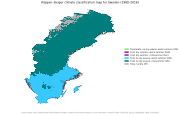
The highest temperature ever recorded in Sweden was 38 °C (100 °F) in Målilla in 1947, while the coldest temperature ever recorded was −52.6 °C (−62.7 °F) in Vuoggatjålme on 2 February 1966.[117] Temperatures expected in Sweden are heavily influenced by the large Fennoscandian landmass, as well as continental Europe and western Russia, which allows hot or cool inland air to be easily transported to Sweden. That, in turn, renders most of Sweden's southern areas having warmer summers than almost everywhere in the nearby British Isles, even matching temperatures found along the continental Atlantic coast as far south as in northern Spain. In winter, however, the same high-pressure systems sometimes put the entire country far below freezing temperatures. There is some maritime moderation from the Atlantic which renders the Swedish continental climate less severe than that of nearby Russia. Even though temperature patterns differ between north and south, the summer climate is surprisingly similar all through the entire country in spite of the large latitudinal differences. This is due to the south's being surrounded by a greater mass of water, with the wider Baltic Sea and the Atlantic air passing over lowland areas from the south-west.
Apart from the ice-free Atlantic bringing marine air into Sweden tempering winters, the mildness is further explained by prevailing low-pressure systems postponing winter, with the long nights often staying above freezing in the south of the country due to the abundant cloud cover. By the time winter finally breaks through, daylight hours rise quickly, ensuring that daytime temperatures soar quickly in spring. With the greater number of clear nights, frosts remain commonplace quite far south as late as April. The cold winters occur when low-pressure systems are weaker. An example is that the coldest ever month (January 1987) in Stockholm was also the sunniest January month on record.[118][119]
The relative strength of low and high-pressure systems of marine and continental air also define the highly variable summers. When hot continental air hits the country, the long days and short nights frequently bring temperatures up to 30 °C (86 °F) or above even in coastal areas. Nights normally remain cool, especially in inland areas. Coastal areas can see so-called tropical nights above 20 °C (68 °F) occur due to the moderating sea influence during warmer summers.[120] Summers can be cool, especially in the north of the country. Transitional seasons are normally quite extensive and the four-season climate applies to most of Sweden's territory, except in Scania where some years do not record a meteorological winter (see table below) or in the high Lapland mountains where polar microclimates exist.
On average, most of Sweden receives between 500 and 800 mm (20 and 31 in) of precipitation each year, making it considerably drier than the global average. The south-western part of the country receives more precipitation, between 1,000 and 1,200 mm (39 and 47 in), and some mountain areas in the north are estimated to receive up to 2,000 mm (79 in). Despite northerly locations, southern and central Sweden may have almost no snow in some winters. Most of Sweden is located in the rain shadow of the Scandinavian Mountains through Norway and north-west Sweden. The blocking of cool and wet air in summer, as well as the greater landmass, leads to warm and dry summers far north in the country, with quite warm summers at the Bothnia Bay coast at 65 degrees latitude, which is unheard of elsewhere in the world at such northerly coastlines.
Swedish Meteorological Institute, SMHI's monthly average temperatures of some of their weather stations – for the latest scientific full prefixed thirty-year period 1961–1990 Next will be presented in year 2020. The weather stations are sorted from south towards north by their numbers.
| stn.nr. | station | Jan | Feb | Mar | Apr | May | Jun | Jul | Aug | Sep | Oct | Nov | Dec | Annual |
|---|---|---|---|---|---|---|---|---|---|---|---|---|---|---|
| 5337 | Malmö | 0.1 | 0.0 | 2.2 | 6.4 | 11.6 | 15.8 | 17.1 | 16.8 | 13.6 | 9.8 | 5.3 | 1.9 | 8.4 |
| 6203 | Helsingborg | 0.6 | −0.1 | 2.0 | 6.0 | 11.2 | 15.3 | 16.7 | 16.6 | 13.6 | 9.9 | 5.2 | 1.8 | 8.3 |
| 6451 | Växjö | −2.8 | −2.8 | 0.0 | 4.7 | 10.2 | 14.3 | 15.3 | 14.9 | 11.2 | 7.0 | 2.3 | −1.2 | 6.1 |
| 7839 | Visby | −0.5 | −1.2 | 0.7 | 4.1 | 9.5 | 14.0 | 16.4 | 16.0 | 12.5 | 8.6 | 4.3 | 1.2 | 7.1 |
| 7447 | Jönköping | −2.6 | −2.7 | 0.3 | 4.7 | 10.0 | 14.5 | 15.9 | 15.0 | 11.3 | 7.5 | 2.8 | −0.7 | 6.3 |
| 7263 | Göteborg | −0.9 | −0.9 | 2.0 | 6.0 | 11.6 | 15.5 | 16.6 | 16.2 | 12.8 | 9.1 | 4.4 | 1.0 | 7.8 |
| 8323 | Skövde | −2.8 | −2.9 | 0.0 | 4.6 | 10.6 | 15.0 | 16.2 | 15.2 | 11.1 | 7.1 | 2.2 | −1.1 | 6.3 |
| 8634 | Norrköping | −3.0 | −3.2 | 0.0 | 4.5 | 10.4 | 15.1 | 16.6 | 15.5 | 11.3 | 7.2 | 2.2 | −1.4 | 6.3 |
| 9516 | Örebro | −4.0 | −4.0 | −0.5 | 4.3 | 10.7 | 15.3 | 16.5 | 15.3 | 10.9 | 6.6 | 1.3 | −2.4 | 5.8 |
| 9720 | Stockholm Bromma | −3.5 | −3.7 | −0.5 | 4.3 | 10.4 | 15.2 | 16.8 | 15.8 | 11.4 | 7.0 | 2.0 | −1.8 | 6.1 |
| 9739 | Stockholm Arlanda | −4.3 | −4.6 | −1.0 | 3.9 | 9.9 | 14.8 | 16.5 | 15.2 | 10.7 | 6.4 | 1.2 | −2.6 | 5.5 |
| 10458 | Mora | −7.4 | −7.2 | −2.4 | 2.5 | 9.1 | 14.1 | 15.4 | 13.5 | 9.3 | 4.9 | −1.6 | −6.1 | 3.7 |
| 10740 | Gävle | −4.8 | −4.5 | −1.0 | 3.4 | 9.3 | 14.6 | 16.3 | 14.9 | 10.6 | 6.0 | 0.6 | −3.3 | 5.2 |
| 12724 | Sundsvall | −7.5 | −6.3 | −2.3 | 2.5 | 8.2 | 13.8 | 15.2 | 13.8 | 9.4 | 4.8 | −1.5 | −5.7 | 3.6 |
| 13410 | Östersund | −8.9 | −7.6 | −3.5 | 1.3 | 7.6 | 12.5 | 13.9 | 12.7 | 8.2 | 3.8 | −2.4 | −6.3 | 2.6 |
| 14050 | Umeå | −8.7 | −8.3 | −4.0 | 1.4 | 7.6 | 13.3 | 15.6 | 13.8 | 9.0 | 4.0 | −2.3 | −6.4 | 2.9 |
| 15045 | Skellefteå | −10.2 | −8.7 | −4.2 | 1.2 | 7.6 | 13.6 | 15.7 | 13.5 | 8.5 | 3.2 | −3.4 | −7.5 | 2.5 |
| 16288 | Luleå | −12.2 | −11.0 | −6.0 | 0.3 | 6.6 | 13.0 | 15.4 | 13.3 | 8.0 | 2.6 | −4.5 | −9.7 | 1.3 |
| 16395 | Haparanda | −12.1 | −11.4 | −6.8 | −0.5 | 6.1 | 12.8 | 15.4 | 13.2 | 8.0 | 2.5 | −4.2 | −9.5 | 1.1 |
| 16988 | Jokkmokk | −17.5 | −14.9 | −8.6 | −1.1 | 5.9 | 12.2 | 14.3 | 11.8 | 5.7 | −0.2 | −9.3 | −14.6 | -1.4 |
| 17897 | Tarfala (a mountain peak) | −11.8 | −11.3 | −10.6 | −7.5 | −1.9 | 3.2 | 6.4 | 5.3 | 0.8 | −3.9 | −7.9 | −10.7 | -4.2 |
| 18076 | Gällivare | −14.3 | −12.5 | −8.4 | −1.9 | 5.0 | 11.0 | 13.0 | 10.7 | 5.6 | −0.6 | −8.1 | −12.2 | -1.1 |
| 18094 | Kiruna | −13.9 | −12.5 | −8.7 | −3.2 | 3.4 | 9.6 | 12.0 | 9.8 | 4.6 | −1.4 | −8.1 | −11.9 | -1.7 |
Vegetation
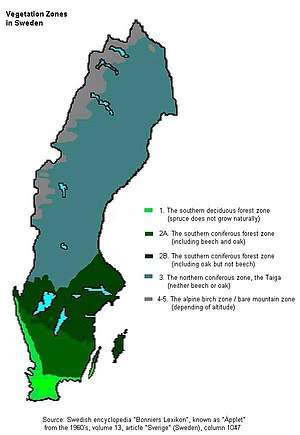
Sweden has a considerable south to north distance (stretching between the latitudes N 55:20:13 and N 69:03:36) which causes large climatic difference, especially during the winter. The related matter of the length and strength of the four seasons plays a role in which plants that naturally can grow at various places. Sweden is divided in five major vegetation zones. These are:
- The southern deciduous forest zone
- The southern coniferous forest zone
- The northern coniferous forest zone, or the Taiga
- The alpine-birch zone
- The bare mountain zone
Please see the map to the right, Vegetation Zones in Sweden.
- Southern deciduous forest zone
Also known as the nemoral region, the southern deciduous forest zone is a part of a larger vegetation zone which also includes Denmark and large parts of Central Europe. It has to a rather large degree become agricultural areas, but larger and smaller forests still exist. The region is characterised by a large wealth of trees and shrubs. The beech are the most dominant tree, but oak can also form smaller forests. elm at one time formed forests, but have been heavily reduced due to Dutch Elm disease. Other important trees and shrubs in this zone include hornbeam, elder, hazel, fly honeysuckle, linden (lime), spindle, yew, alder buckthorn, blackthorn, aspen, European rowan, Swedish whitebeam, juniper, European holly, ivy, dogwood, goat willow, larch, bird cherry, wild cherry, maple, ash, alder along creeks, and in sandy soil birch compete with pine.[123] Spruce is not native but between approximately 1870 and 1980, large areas were planted with it.[124] They tend to grow too quickly due to being outside of their native range[125] and large distances between the tree rings cause poor board quality.[126] Later some spruce trees began to die before reaching optimal height, and many more of the coniferous trees were uprooted during cyclones.[127][128] During the last 40–50 years large areas of former spruce plantings have been replanted with deciduous forest.[129]
- Southern coniferous forest zone
Also known as the boreo-nemoral region, the southern coniferous forest zone is delimited by the oak's northern natural limit (limes norrlandicus) and the Spruce's southern natural limit,[130] between the southern deciduous zone and the Taiga farther north. In the southern parts of this zone the coniferous species are found, mainly spruce and pine, mixed with various deciduous trees. Birch grows largely everywhere. The beech's northern boundary crosses this zone. This is however not the case with oak and ash. Although in its natural area, also planted Spruce are common, and such woods are very dense, as the spruces can grow very tight, especially in this vegetation zone's southern areas.
- Northern coniferous forest zone, or the Taiga
The northern coniferous forest zone begins north of the natural boundary of the oak. Of deciduous species the birch is the only one of significance. Pine and spruce are dominant, but the forests are slowly but surely more sparsely grown the farther towards the north it gets. In the extreme north is it difficult to state the trees forms true forests at all, due to the large distances between the trees.
- Alpine-birch and bare mountain zones
The alpine-birch zone, in the Scandinavian mountains, depending on both latitude and altitude, is an area where only a smaller kind of birch (Betula pubescens or B.tortuosa) can grow. Where this vegetation zone ends, no trees grow at all: the bare mountain zone.[131]
Politics
Constitutional framework
.jpg)
Sweden has four fundamental laws (Swedish: grundlagar) which together form the Constitution: the Instrument of Government (Swedish: Regeringsformen), the Act of Succession (Swedish: Successionsordningen), the Freedom of the Press Act (Swedish: Tryckfrihetsförordningen), and the Fundamental Law on Freedom of Expression (Swedish: Yttrandefrihetsgrundlagen).[132][133]
The public sector in Sweden is divided into two parts: the legal person known as the State (Swedish: staten)[lower-alpha 2] and local authorities:[lower-alpha 3] the latter include regional County Councils (Swedish: landsting) and local Municipalities (Swedish: kommuner).[134][135][136][137] The local authorities, rather than the State, make up the larger part of the public sector in Sweden.[138] County Councils and Municipalities are independent of one another, the former merely covers a larger geographical area than the latter.[138][139] The local authorities have self-rule, as mandated by the Constitution, and their own tax base.[135][140] Notwithstanding their self-rule, local authorities are nevertheless in practice interdependent upon the State, as the parameters of their responsibilities and the extent of their jurisdiction are specified in the Local Government Act (Swedish: Kommunallagen) passed by the Riksdag.[135][141]
Sweden is a constitutional monarchy, and King Carl XVI Gustaf is the head of state, but the role of the monarch is limited to ceremonial and representative functions.[142] Under the provisions of the 1974 Instrument of Government, the King lacks any formal political power.[143][144] The King opens the annual Riksdag session, chairs the Special Council held during a change of Government, holds regular Information Councils with the Prime Minister and the Government, chairs the meetings of the Advisory Council on Foreign Affairs (Swedish: Utrikesnämnden), and receives Letters of Credence of foreign ambassadors to Sweden and signs those of Swedish ambassadors sent abroad.[145][146] In addition, the King pays State Visits abroad and receives those incoming as host.[145] Apart from strictly official duties, the King and the other members of Royal Family undertake a variety of unofficial and other representative duties within Sweden and abroad.[147]
Legislative power is vested in the unicameral Riksdag with 349 members. General elections are held every four years, on the second Sunday of September. Legislation may be initiated by the Government or by members of the Riksdag. Members are elected on the basis of proportional representation to a four-year term. The internal workings of the Riksdag are, in addition to the Instrument of Government, regulated by the Riksdag Act (Swedish: Riksdagsordningen).[148] The fundamental laws can be altered by the Riksdag alone; only an absolute majority with two separate votes, separated by a general election in between, is required.[132]
The Government (Swedish: Regeringen) operates as a collegial body with collective responsibility and consists of the Prime Minister — appointed and dismissed by the Speaker of the Riksdag (following an actual vote in the Riksdag before an appointment can be made) — and other cabinet ministers (Swedish: Statsråd), appointed and dismissed at the sole discretion of the Prime Minister.[150] The Government is the supreme executive authority and is responsible for its actions to the Riksdag.[151]
Most of the State administrative authorities (Swedish: statliga förvaltningsmyndigheter) report to the Government, including (but not limited to) the Armed Forces, the Enforcement Authority, the National Library, the Swedish police and the Tax Agency. A unique feature of Swedish State administration is that individual cabinet ministers do not bear any individual ministerial responsibility for the performance of the agencies within their portfolio; as the director-generals and other heads of government agencies reports directly to the Government as a whole; and individual ministers are prohibited to interfere; thus the origin of the pejorative in Swedish political parlance term ministerstyre (English: "ministerial rule") in matters that are to be handled by the individual agencies, unless otherwise specifically provided for in law.
The Judiciary is independent from the Riksdag, Government and other State administrative authorities.[152] The role of judicial review of legislation is not practised by the courts; instead, the Council on Legislation gives non-binding opinions on legality.[153] There is no stare decisis in that courts are not bound by precedent, although it is influential.[154]
Political parties and elections
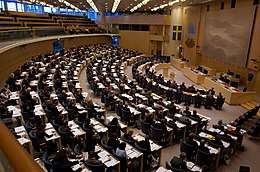
The Swedish Social Democratic Party has played a leading role in Swedish politics since 1917, after the Reformists had confirmed their strength and the left-wing revolutionaries formed their own party. After 1932, most governments have been dominated by the Social Democrats. Only five general elections since World War II—1976, 1979, 1991, 2006 and 2010—have given the assembled bloc of centre-right parties enough seats in the Riksdag to form a government.
For over 50 years, Sweden had had five parties who continually received enough votes to gain seats in the Riksdag—the Social Democrats, the Moderate Party, the Centre Party, the Liberal People's Party and the Left Party—before the Green Party became the sixth party in the 1988 election. In the 1991 election, while the Greens lost their seats, two new parties gained seats for the first time: the Christian Democrats and New Democracy. The 1994 election saw the return of the Greens and the demise of New Democracy. It was not until elections in 2010 that an eighth party, the Sweden Democrats, gained Riksdag seats. In the elections to the European Parliament, parties who have failed to pass the Riksdag threshold have managed to gain representation at that venue: the June List (2004–2009), the Pirate Party (2009–2014), and Feminist Initiative (2014–2019).
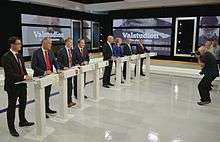
In the 2006 general election the Moderate Party formed the centre-right Alliance for Sweden bloc and won a majority of the Riksdag seats. In the 2010 general election the Alliance contended against a unified left block consisting of the Social Democrats, the Greens and the Left Party.[155] The Alliance won a plurality of 173 seats, but remained two seats short of a 175-seat majority. Nevertheless, neither the Alliance, nor the left block, chose to form a coalition with the Sweden Democrats.[156]
The outcome of the 2014 general election resulted in the attainment of more seats by the three centre-left parties in comparison to the centre-right Alliance for Sweden, with the two blocs receiving 159 and 141 seats respectively.[157] The non-aligned Sweden Democrats more than doubled their support and won the remaining 49 seats.[157] On 3 October 2014, Stefan Löfven formed a minority government consisting of the Social Democrats and the Greens.[158][159]
Election turnout in Sweden has always been high by international comparison. Although it declined in recent decades, the latest elections saw an increase in voter turnout (80.11% in 2002, 81.99% in 2006, 84.63% in 2010, 85.81 in 2014)[160] and 87.18 % in 2018.[161] Swedish politicians enjoyed a high degree of confidence from the citizens in the 1960s, However, that level of confidence has since declined steadily, and is now at a markedly lower level than in its Scandinavian neighbours.[162]
Administrative divisions
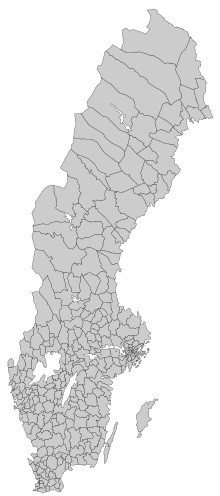
Sweden is a unitary state divided into 21 county councils (landsting) and 290 municipalities (kommuner). Every county council corresponds to a county (län) with a number of municipalities per county. County councils and municipalities have different roles and separate responsibilities relating to local government. Health care, public transport and certain cultural institutions are administered by county councils. Preschools, primary and secondary schooling, public water utilities, garbage disposal, elderly care and rescue services are administered by the municipalities. Gotland is a special case of being a county council with only one municipality and the functions of county council and municipality are performed by the same organisation.[163]
Municipal and county council government in Sweden is similar to city commission and cabinet-style council government. Both levels have legislative assemblies (municipal councils and county council assemblies of between 31 and 101 members (always an uneven number) that are elected from party-list proportional representation at the general election which are held every four years in conjunction with the national parliamentary elections.
Municipalities are also divided into a total of 2,512 parishes (församlingar). These have no official political responsibilities but are traditional subdivisions of the Church of Sweden and still have some importance as census districts for census-taking and elections.
The Swedish government has 21 County Administrative Boards (Swedish: länsstyrelser), which are responsible for regional state administration not assigned to other government agencies or local government. Each county administrative boards is led by a County Governor (Swedish: landshövding) appointed for a term of six years. The list of previous officeholders for the counties stretches back, in most cases, to 1634 when the counties were created by Lord High Chancellor Count Axel Oxenstierna. The main responsibility of the County Administrative Board is to co-ordinate the development of the county in line with goals set by the Riksdag and Government.
There are older historical divisions, primarily the twenty-five provinces and three lands, which still retain cultural significance.
Political history
The actual age of the kingdom of Sweden is unknown.[164] Establishing the age depends mostly on whether Sweden should be considered a nation when the Svear (Sweonas) ruled Svealand or if the emergence of the nation started with the Svear and the Götar (Geats) of Götaland being united under one ruler. In the first case, Svealand was first mentioned as having one single ruler in the year 98 by Tacitus, but it is almost impossible to know for how long it had been this way. However, historians usually start the line of Swedish monarchs from when Svealand and Götaland were ruled under the same king, namely Eric the Victorious (Geat) and his son Olof Skötkonung in the 10th century. These events are often described as the consolidation of Sweden, although substantial areas were conquered and incorporated later.
Earlier kings, for which no reliable historical sources exist, can be read about in mythical kings of Sweden and semi-legendary kings of Sweden. Many of these kings are only mentioned in various saga and blend with Norse mythology.
The title Sveriges och Götes Konung was last used for Gustaf I of Sweden, after which the title became "King of Sweden, of the Goths and of the Wends" (Sveriges, Götes och Vendes Konung) in official documentation. Up until the beginning of the 1920s, all laws in Sweden were introduced with the words, "We, the king of Sweden, of the Goths and Wends". This title was used up until 1973.[165] The present King of Sweden, Carl XVI Gustaf, was the first monarch officially proclaimed "King of Sweden" (Sveriges Konung) with no additional peoples mentioned in his title.
The term riksdag was used for the first time in the 1540s, although the first meeting where representatives of different social groups were called to discuss and determine affairs affecting the country as a whole took place as early as 1435, in the town of Arboga.[166] During the Riksdag assemblies of 1527 and 1544, under King Gustav Vasa, representatives of all four estates of the realm (clergy, nobility, townsmen and peasants) were called on to participate for the first time.[166] The monarchy became hereditary in 1544.
Executive power was historically shared between the King and an aristocratic Privy council until 1680, followed by the King's autocratic rule initiated by the commoner estates of the Riksdag. As a reaction to the failed Great Northern War, a parliamentary system was introduced in 1719, followed by three different flavours of constitutional monarchy in 1772, 1789 and 1809, the latter granting several civil liberties. Already during the first of those three periods, the 'Era of Liberty' (1719–72) the Swedish Rikstag had developed into a very active Parliament, and this tradition continued into the nineteenth century, laying the basis for the transition towards modern democracy at the end of that century.[167]
In 1866 Sweden became a constitutional monarchy with a bicameral parliament, with the First Chamber indirectly elected by local governments, and the Second Chamber directly elected in national elections every four years. In 1971 the parliament became unicameral. Legislative power was (symbolically) shared between the King and the Riksdag until 1975. Swedish taxation is controlled by the Riksdag.
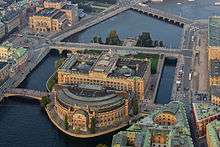
Sweden has a history of strong political involvement by ordinary people through its "popular movements" (Folkrörelser), the most notable being trade unions, the independent Christian movement, the temperance movement, the women's movement, and the intellectual property pirate movements. Sweden was the first country in the world to outlaw corporal punishment of children by their parents (parents' right to spank their own children was first removed in 1966, and it was explicitly prohibited by law from July 1979[168]).
Sweden is currently leading the EU in statistics measuring equality in the political system and equality in the education system.[169] The Global Gender Gap Report 2006 ranked Sweden as the number one country in terms of gender equality.[170]
Some Swedish political figures have become known worldwide, among these are: Raoul Wallenberg, Folke Bernadotte, the former Secretary-General of the United Nations Dag Hammarskjöld, the former Prime Minister Olof Palme, the former Prime Minister and later Foreign minister Carl Bildt, the former President of the General Assembly of the United Nations Jan Eliasson, and the former International Atomic Energy Agency Iraq inspector Hans Blix.
Judicial system
The courts are divided into two parallel and separate systems: The general courts (allmänna domstolar) for criminal and civil cases, and general administrative courts (allmänna förvaltningsdomstolar) for cases relating to disputes between private persons and the authorities.[171] Each of these systems has three tiers, where the top tier court of the respective system typically only will hear cases that may become precedent. There are also a number of special courts, which will hear a narrower set of cases, as set down by legislation. While independent in their rulings, some of these courts are operated as divisions within courts of the general or general administrative courts.
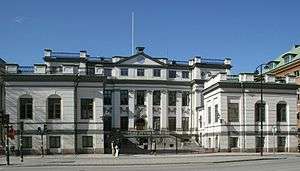
The Supreme Court of Sweden (Swedish: Högsta domstolen) is the third and final instance in all civil and criminal cases in Sweden. Before a case can be decided by the Supreme Court, leave to appeal must be obtained, and with few exceptions, leave to appeal can be granted only when the case is of interest as a precedent. The Supreme Court consists of 16 Justices (Swedish: justitieråd), appointed by the Government, but the court as an institution is independent of the Riksdag, and the Government is not able to interfere with the decisions of the court.
According to a victimisation survey of 1,201 residents in 2005, Sweden has above-average crime rates compared to other EU countries. Sweden has high or above-average levels of assaults, sexual assaults, hate crimes, and consumer fraud. Sweden has low levels of burglary, car theft and drug problems. Bribe seeking is rare.[172]
A mid-November 2013 news report announced that four prisons in Sweden were closed during the year due to a significant drop in the number of inmates. The decrease in the number of Swedish prisoners was considered "out-of-the-ordinary" by the head of Sweden's prison and probation services, with prison numbers in Sweden falling by around 1% a year since 2004. Prisons were closed in the towns of Åby, Håja, Båtshagen, and Kristianstad.[173]
Foreign relations
Throughout the 20th century, Swedish foreign policy was based on the principle of non-alignment in peacetime and neutrality in wartime. Sweden's government pursued an independent course of nonalignment in times of peace so that neutrality would be possible in the event of war.[94]
Sweden's doctrine of neutrality is often traced back to the 19th century as the country has not been in a state of war since the end of the Swedish campaign against Norway in 1814. During World War II Sweden joined neither the allied nor axis powers. This has sometimes been disputed since in effect Sweden allowed in select cases the Nazi regime to use its railroad system to transport troops and goods,[89][91] especially iron ore from mines in northern Sweden, which was vital to the German war machine.[91][174] However, Sweden also indirectly contributed to the defence of Finland in the Winter War, and permitted the training of Norwegian and Danish troops in Sweden after 1943.

During the early Cold War era, Sweden combined its policy of non-alignment and a low profile in international affairs with a security policy based on strong national defence.[175] The function of the Swedish military was to deter attack.[176] At the same time, the country maintained relatively close informal connections with the Western bloc, especially in the realm of intelligence exchange. In 1952, a Swedish DC-3 was shot down over the Baltic Sea by a Soviet MiG-15 jet fighter. Later investigations revealed that the plane was actually gathering information for NATO.[177] Another plane, a Catalina search and rescue plane, was sent out a few days later and shot down by the Soviets as well. Prime Minister Olof Palme made an official visit to Cuba during the 1970s, during which he denounced Fulgencio Batista's government and praised contemporary Cuban and Cambodian revolutionaries in a speech.
Beginning in the late 1960s, Sweden attempted to play a more significant and independent role in international relations. It involved itself significantly in international peace efforts, especially through the United Nations, and in support to the Third World.
On 27 October 1981, a Whiskey-class submarine (U 137) from the Soviet Union ran aground close to the naval base at Karlskrona in the southern part of the country. Research has never clearly established whether the submarine ended up on the shoals through a navigational mistake or if an enemy committed espionage against Swedish military potential. The incident triggered a diplomatic crisis between Sweden and the Soviet Union. Following the 1986 assassination of Olof Palme and with the end of the Cold War, Sweden has adopted a more traditional foreign policy approach. Nevertheless, the country remains active in peace keeping missions and maintains a considerable foreign aid budget.
Since 1995 Sweden has been a member of the European Union, and as a consequence of a new world security situation the country's foreign policy doctrine has been partly modified, with Sweden playing a more active role in European security co-operation.
Military
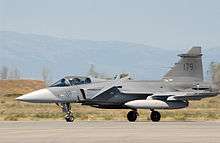
The law is enforced in Sweden by several government entities. The Swedish police is a Government agency concerned with police matters. The National Task Force is a national SWAT unit within the police force. The Swedish Security Service's responsibilities are counter-espionage, anti-terrorist activities, protection of the constitution and protection of sensitive objects and people.
The Försvarsmakten (Swedish Armed Forces) are a government agency reporting to the Swedish Ministry of Defence and responsible for the peacetime operation of the armed forces of Sweden. The primary task of the agency is to train and deploy peacekeeping forces abroad, while maintaining the long-term ability to refocus on the defence of Sweden in the event of war. The armed forces are divided into Army, Air Force and Navy. The head of the armed forces is the Supreme Commander (Överbefälhavaren, ÖB), the most senior commissioned officer in the country. Up to 1974, the King was pro forma Commander-in-Chief, but in reality it was clearly understood through the 20th century that the monarch would have no active role as a military leader.
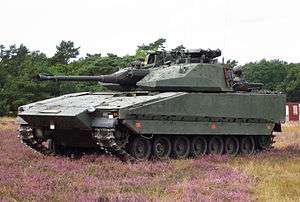
Until the end of the Cold War, nearly all males reaching the age of military service were conscripted. In recent years, the number of conscripted males has shrunk dramatically, while the number of female volunteers has increased slightly. Recruitment has generally shifted towards finding the most motivated recruits, rather than solely focusing on those otherwise most fit for service. By law, all soldiers serving abroad must be volunteers. In 1975, the total number of conscripts was 45,000. By 2003, it was down to 15,000.
On 1 July 2010, Sweden ended routine conscription, switching to an all-volunteer force unless otherwise required for defence readiness.[178][179][180] Emphasis was to be placed on only recruiting those later prepared to volunteer for international service. The total forces gathered would consist of about 60,000 personnel. This in comparison with the 1980s, before the fall of the Soviet Union, when Sweden could gather up to 1,000,000 servicemembers.
However, on 11 December 2014, due to tensions in the Baltic area, the Swedish Government reintroduced one part of the Swedish conscription system, refresher training.[181] On 2 March 2017, the government decided to reintroduce the remaining part of the Swedish conscription system, basic military training. The first recruits began their training in 2018. As the law is now gender neutral, both men and women may have to serve.[182] Sweden decided not to sign the UN treaty on the Prohibition of Nuclear Weapons.[183]
Swedish units have taken part in peacekeeping operations in the Democratic Republic of the Congo, Cyprus, Bosnia and Herzegovina, Kosovo, Liberia, Lebanon, Afghanistan and Chad.
Economy
.png)
Sweden is the sixteenth-richest country in the world in terms of GDP (gross domestic product) per capita and a high standard of living is experienced by its citizens. Sweden is an export-oriented mixed economy. Timber, hydropower and iron ore constitute the resource base of an economy with a heavy emphasis on foreign trade. Sweden's engineering sector accounts for 50% of output and exports, while telecommunications, the automotive industry and the pharmaceutical industries are also of great importance. Sweden is the ninth-largest arms exporter in the world. Agriculture accounts for 2% of GDP and employment. The country ranks among the highest for telephone and Internet access penetration.[184]
Trade unions, employers' associations and collective agreements cover a large share of the employees in Sweden.[185][186] The high coverage of collective agreements is achieved despite the absence of state mechanisms extending collective agreements to whole industries or sectors. Both the prominent role of collective bargaining and the way in which the high rate of coverage is achieved reflect the dominance of self-regulation (regulation by the labour market parties themselves) over state regulation in Swedish industrial relations.[187] When the Swedish Ghent system was changed in 2007, resulting in considerably raised fees to unemployment funds, a substantial decline in union density and density of unemployment funds occurred.[188][189]
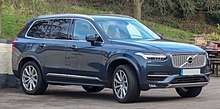
In 2010 Sweden's income Gini coefficient was the third lowest among developed countries, at 0.25—slightly higher than Japan and Denmark—suggesting Sweden had low income inequality. However, Sweden's wealth Gini coefficient at 0.853 was the second highest in developed countries, and above European and North American averages, suggesting high wealth inequality.[190][191] Even on a disposable income basis, the geographical distribution of Gini coefficient of income inequality varies within different regions and municipalities of Sweden. Danderyd, outside Stockholm, has Sweden's highest Gini coefficient of income inequality, at 0.55, while Hofors near Gävle has the lowest at 0.25. In and around Stockholm and Scania, two of the more densely populated regions of Sweden, the income Gini coefficient is between 0.35 and 0.55.[192]
In terms of structure, the Swedish economy is characterised by a large, knowledge-intensive and export-oriented manufacturing sector; an increasing, but comparatively small, business service sector; and by international standards, a large public service sector. Large organisations, both in manufacturing and services, dominate the Swedish economy.[193] High and medium-high technology manufacturing accounts for 9.9% of GDP.[194]
The 20 largest (by turnover) registered Swedish companies in 2007 were Volvo, Ericsson, Vattenfall, Skanska, Sony Ericsson Mobile Communications AB, Svenska Cellulosa Aktiebolaget, Electrolux, Volvo Personvagnar, TeliaSonera, Sandvik, Scania, ICA, Hennes & Mauritz, IKEA, Nordea, Preem, Atlas Copco, Securitas, Nordstjernan and SKF.[195] The vast majority of Sweden's industry is privately controlled, unlike many other industrialised Western countries, and, in accordance with a historical standard, publicly owned enterprises are of minor importance.
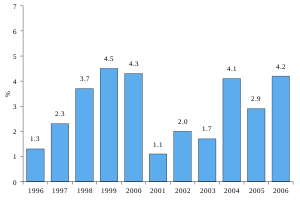
An estimated 4.5 million Swedish residents are employed and around a third of the workforce completed tertiary education. In terms of GDP per-hour-worked, Sweden was the world's ninth highest in 2006 at US$31, compared to US$22 in Spain and US$35 in the United States.[196] GDP per-hour-worked is growing 2.5% per year for the economy as a whole and the trade-terms-balanced productivity growth is 2%.[196] According to the OECD, deregulation, globalisation, and technology sector growth have been key productivity drivers.[196] Sweden is a world leader in privatised pensions and pension funding problems are relatively small compared to many other Western European countries.[197] A pilot program to test the feasibility of a six-hour workday, without loss of pay, will commence in 2014, involving the participation of Gothenburg municipal staff. The Swedish government is seeking to reduce its costs through decreased sick leave hours and increased efficiency.[198]
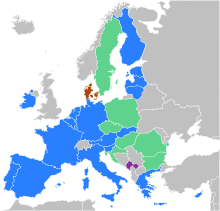
The typical worker receives 40% of his or her labour costs after the tax wedge. Total tax collected by Sweden as a percentage of its GDP peaked at 52.3% in 1990.[199] The country faced a real estate and banking crisis in 1990–1991, and consequently passed tax reforms in 1991 to implement tax rate cuts and tax base broadening over time.[200][201] Since 1990, taxes as a percentage of GDP collected by Sweden have been dropping, with total tax rates for the highest income earners dropping the most.[202] In 2010 45.8% of the country's GDP was collected as taxes, the second highest among OECD countries, and nearly double the percentage in the US or South Korea.[199] Tax income-financed employment represents a third of the Swedish workforce, a substantially higher proportion than in most other countries. Overall, GDP growth has been fast since reforms—especially those in manufacturing—were enacted in the early 1990s.[203]
Sweden is the fourth-most competitive economy in the world, according to the World Economic Forum in its Global Competitiveness Report 2012–2013.[29] Sweden is the top performing country in the 2014 Global Green Economy Index (GGEI).[204] Sweden is ranked fourth in the IMD World Competitiveness Yearbook 2013.[205] According to the book The Flight of the Creative Class by the US economist Professor Richard Florida of the University of Toronto, Sweden is ranked as having the best creativity in Europe for business and is predicted to become a talent magnet for the world's most purposeful workers. The book compiled an index to measure the kind of creativity it claims is most useful to business—talent, technology and tolerance.[206]
Sweden maintains its own currency, the Swedish krona (SEK), a result of the Swedes having rejected the euro in a referendum. The Swedish Riksbank—founded in 1668 and thus the oldest central bank in the world—is currently focusing on price stability with an inflation target of 2%. According to the Economic Survey of Sweden 2007 by the OECD, the average inflation in Sweden has been one of the lowest among European countries since the mid-1990s, largely because of deregulation and quick utilisation of globalisation.[196]
The largest trade flows are with Germany, the United States, Norway, the United Kingdom, Denmark and Finland.
Financial deregulation in the 1980s impacted adversely on the property market, leading to a bubble and eventually a crash in the early 1990s. Commercial property prices fell by up to two thirds, resulting in two Swedish banks having to be taken over by the government. In the following two decades the property sector strengthened. By 2014, legislators, economists and the IMF were again warning of a bubble with residential property prices soaring and the level of personal mortgage debt expanding. Household debt-to-income rose above 170% as the IMF was calling on legislators to consider zoning reform and other means of generating a greater supply of housing as demand was outstripping what was available, pushing prices higher. By August 2014, 40% of home borrowers had interest-only loans while those that didn't were repaying principal at a rate that would take 100 years to fully repay.[207]
Energy
Sweden's energy market is largely privatised. The Nordic energy market is one of the first liberalised energy markets in Europe and it is traded in NASDAQ OMX Commodities Europe and Nord Pool Spot. In 2006, out of a total electricity production of 139 TWh, electricity from hydropower accounted for 61 TWh (44%), and nuclear power delivered 65 TWh (47%). At the same time, the use of biofuels, peat etc. produced 13 TWh (9%) of electricity, while wind power produced 1 TWh (1%). Sweden was a net importer of electricity by a margin of 6 TWh.[208] Biomass is mainly used to produce heat for district heating and central heating and industry processes.
The 1973 oil crisis strengthened Sweden's commitment to decrease dependence on imported fossil fuels. Since then, electricity has been generated mostly from hydropower and nuclear power. The use of nuclear power has been limited, however. Among other things, the accident of Three Mile Island Nuclear Generating Station (United States) prompted the Riksdag to ban new nuclear plants. In March 2005, an opinion poll showed that 83% supported maintaining or increasing nuclear power.[209] Politicians have made announcements about oil phase-out in Sweden, decrease of nuclear power, and multibillion-dollar investments in renewable energy and energy efficiency.[210][211] The country has for many years pursued a strategy of indirect taxation as an instrument of environmental policy, including energy taxes in general and carbon dioxide taxes in particular.[210] Sweden was in 2014 a net exporter of electricity by a margin of 16 TWh; the production from windpower mills had increased to 11.5 TWh.[212]
Transport
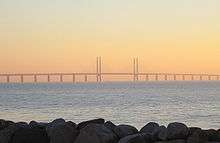
Sweden has 162,707 km (101,101 mi) of paved road and 1,428 km (887 mi) of expressways. Motorways run through Sweden and over the Øresund Bridge to Denmark. New motorways are still under construction and a new motorway from Uppsala to Gävle was finished on 17 October 2007. Sweden had left-hand traffic (Vänstertrafik in Swedish) from approximately 1736 and continued to do so well into the 20th century. Voters rejected right-hand traffic in 1955, but after the Riksdag passed legislation in 1963 changeover took place on 3 September 1967, known in Swedish as Dagen H.
The Stockholm metro is the only underground system in Sweden and serves the city of Stockholm via 100 stations. The rail transport market is privatised, but while there are many privately owned enterprises, the largest operators are still owned by state. The counties have financing, ticket and marketing responsibility for local trains. For other trains the operators handle tickets and marketing themselves. Operators include SJ, Veolia Transport, DSB, Green Cargo, Tågkompaniet and Inlandsbanan. Most of the railways are owned and operated by Trafikverket.
Most tram nets were closed in 1967, as Sweden changed from left-side to right-side driving. But they survived in Norrköping, Stockholm and Gothenburg, with Gothenburg tram network being the largest. A new tram line is set to open in Lund in 2019.
The largest airports include Stockholm–Arlanda Airport (16.1 million passengers in 2009) 40 km (25 mi) north of Stockholm, Göteborg Landvetter Airport (4.3 million passengers in 2008), and Stockholm–Skavsta Airport (2.0 million passengers). Sweden hosts the two largest port companies in Scandinavia, Port of Göteborg AB (Gothenburg) and the transnational company Copenhagen Malmö Port AB. The most used airport for a large part of Southern Sweden is Kastrup or Copenhagen Airport which is located only 12 minutes by train from the closest Swedish railway station, Hyllie. Copenhagen Airport also is the largest international airport in Scandinavia and Finland.
Sweden also has a number of car ferry connections to several neighbouring countries.[213] This includes a route from Umeå across the Gulf of Bothnia to Vaasa in Finland. There are several connections from the Stockholm area across the Sea of Åland to Mariehamn in the Åland Islands as well as Turku and Helsinki on the Finnish mainland and beyond to Estonia and St Petersburg in Russia. Ferry routes from the Stockholm area also connect with Ventspils and Riga in Latvia as well as Gdańsk in Poland across the Baltic Sea. The ferry ports of Karlskrona and Karlshamn in southeastern Sweden serve Gdynia, Poland, and Klaipeda, Lithuania. Ystad and Trelleborg near the southern tip of Sweden have ferry links with the Danish island of Bornholm and the German ports of Sassnitz, Rostock and Travemünde, respectively, and ferries run to Świnoujście, Poland, from both of them. Trelleborg is the busiest ferry port in Sweden in terms of weight transported by lorry.[214] Its route to Sassnitz started as a steam-operated railway ferry in the 19th century, and today's ferry still carries trains to Berlin during the summer months.[215] Another ferry route to Travemünde originates from Malmö. Despite the opening of the fixed link to Denmark, the Øresund Bridge, the busiest ferry route remains the short link across the narrowest section of the Øresund between Helsingborg and the Danish port of Helsingør, known as the HH Ferry route. There are over seventy departures a day each way; during peak times, a ferry departs every fifteen minutes.[216] Ports higher up the Swedish west coast include Varberg, with a ferry connection across the Kattegat to Grenaa in Denmark, and Göteborg, serving Frederikshavn at the northern tip of Denmark and Kiel in Germany. Finally, there are ferries from Strömstad near the Norwegian border to destinations around the Oslofjord in Norway. There used to be ferry services to the United Kingdom from Göteborg to destinations such as Immingham, Harwich and Newcastle, but these have been discontinued.
Sweden has two domestic ferry lines with large vessels, both connecting Gotland with the mainland. The lines leave from Visby harbour on the island, and the ferries sail to either Oskarshamn or Nynäshamn.[217] A smaller car ferry connects the island of Ven in Øresund with Landskrona.[218]
Public policy
Sweden has one of the most highly developed welfare states in the world. According to a 2012 OECD report, the country had the second-highest public social spending as a percentage of its GDP after France (27.3% and 28.4%, respectively), and the third-highest total (public and private) social spending at 30.2% of its GDP, after France and Belgium (31.3% and 31.0%, respectively).[219] Sweden spent 6.3% of its GDP, the 9th-highest among 34 OECD countries, to provide equal access to education.[220] On health care, the country spent 10.0% of its total GDP, the 12th highest.[221]
Historically, Sweden provided solid support for free trade (except agriculture) and mostly relatively strong and stable property rights (both private and public), though some economists have pointed out that Sweden promoted industries with tariffs and used publicly subsidised R&D during the country's early critical years of industrialisation.[222] After World War II a succession of governments expanded the welfare state by raising the taxes. During this period Sweden's economic growth was also one of the highest in the industrial world. A series of successive social reforms transformed the country into one of the most equal and developed on earth. The consistent growth of the welfare state led to Swedes achieving unprecedented levels of social mobility and quality of life—to this day Sweden consistently ranks at the top of league tables for health, literacy and Human Development—far ahead of some wealthier countries (for example the United States).[223]
However, from the 1970s and onwards Sweden's GDP growth fell behind other industrialised countries and the country's per capita ranking fell from 4th to 14th place in a few decades.[224] From the mid-1990s until today Sweden's economic growth has once again accelerated and has been higher than in most other industrialised countries (including the US) during the last 15 years.[225] A report from the United Nations Development Program predicted that Sweden's rating on the Human Development Index will fall from 0.949 in 2010 to 0.906 in 2030.[226]
Sweden began slowing the expansion of the welfare state in the 1980s, and even trimming it back. Sweden has been relatively quick to adopt neoliberal policies, such as privatization, financialization and deregulation,[227][228] compared to countries such as France.[196][229] The current Swedish government is continuing the trend of moderate rollbacks of previous social reforms.[196][230] Growth has been higher than in many other EU-15 countries. Also since the mid-1980s, Sweden has had the fastest growth in inequality of any developed nation, according to the OECD. This has largely been attributed to the reduction in state benefits and a shift toward the privatisation of public services. According to Barbro Sorman, an activist of the opposition Left Party, "The rich are getting richer, and the poor are getting poorer. Sweden is starting to look like the USA." Nevertheless, it remains far more egalitarian than most nations.[106][231] Partly as a result of these privatisations and widening economic disparity, the Swedes in the 2014 elections put the Social Democrats back in power.[232][233]
Sweden adopted free market agricultural policies in 1990. Since the 1930s, the agricultural sector had been subject to price controls. In June 1990, the Riksdag voted for a new agricultural policy marking a significant shift away from price controls. As a result, food prices fell somewhat. However, the liberalisations soon became moot because EU agricultural controls supervened.[234]
Since the late 1960s, Sweden has had the highest tax quota (as percentage of GDP) in the industrialised world, although today the gap has narrowed and Denmark has surpassed Sweden as the most heavily taxed country among developed countries. Sweden has a two-step progressive tax scale with a municipal income tax of about 30% and an additional high-income state tax of 20–25% when a salary exceeds roughly 320,000 SEK per year. Payroll taxes amount to 32%. In addition, a national VAT of 25% is added to many things bought by private citizens, with the exception of food (12% VAT), transportation, and books (6% VAT). Certain items are subject to additional taxes, e.g. electricity, petrol/diesel and alcoholic beverages.
In 2007, total tax revenue was 47.8% of GDP, the second-highest tax burden among developed countries, down from 49.1% 2006.[235] Sweden's inverted tax wedge – the amount going to the service worker's wallet – is approximately 15%, compared to 10% in Belgium, 30% in Ireland, and 50% in the United States.[224] Public sector spending amounts to 53% of the GDP. State and municipal employees total around a third of the workforce, much more than in most Western countries. Only Denmark has a larger public sector (38% of Danish workforce). Spending on transfers is also high.
In 2015 and 2016, 69 per cent of the employed workers is organised in trade unions. Union density in 2016 was 62% among blue-collar-workers (most of them in the Swedish Trade Union Confederation, LO) and 75% among white-collar workers (most of them in the Swedish Confederation of Professional Employees, TCO, and the Swedish Confederation of Professional Associations, SACO).[236] Sweden has state-supported union unemployment funds (Ghent system).[237] Trade unions have the right to elect two representatives to the board in all Swedish companies with more than 25 employees. Sweden has a relatively high amount of sick leave per worker in OECD: the average worker loses 24 days due to sickness.[203]
The unemployment rate was 7.2% in May 2017 while the employment rate was 67.4%, with the workforce consisting of 4,983,000 people while 387,000 are unemployed.[238][239] Unemployment among youth (aged 24 or younger) in 2012 was 24.2%, making Sweden the OECD country with the highest ratio of youth unemployment versus unemployment in general.[240]
Science and technology

In the 18th century Sweden's scientific revolution took off. Previously, technical progress had mainly come from mainland Europe.
In 1739, the Royal Swedish Academy of Sciences was founded, with people such as Carl Linnaeus and Anders Celsius as early members. Many of the companies founded by early pioneers still remain major international brands. Gustaf Dalén founded AGA, and received the Nobel Prize for his sun valve. Alfred Nobel invented dynamite and instituted the Nobel Prizes. Lars Magnus Ericsson started the company bearing his name, Ericsson, still one of the largest telecom companies in the world. Jonas Wenström was an early pioneer in alternating current and is along with Serbian inventor Nikola Tesla credited as one of the inventors of the three-phase electrical system.[241]
The traditional engineering industry is still a major source of Swedish inventions, but pharmaceuticals, electronics and other high-tech industries are gaining ground. Tetra Pak was an invention for storing liquid foods, invented by Erik Wallenberg. Losec, an ulcer medicine, was the world's best-selling drug in the 1990s and was developed by AstraZeneca. More recently Håkan Lans invented the Automatic Identification System, a worldwide standard for shipping and civil aviation navigation. A large portion of the Swedish economy is to this day based on the export of technical inventions, and many large multinational corporations from Sweden have their origins in the ingenuity of Swedish inventors.[241]
Swedish inventors held 47,112 patents in the United States in 2014, according to the United States Patent and Trademark Office. As a nation, only ten other countries hold more patents than Sweden.[242]
Combined, the public and the private sector in Sweden allocate over 3.5% of GDP to research & development (R&D) per year, making Sweden's investment in R&D as a percentage of GDP the second-highest in the world.[243] For several decades the Swedish government has prioritised scientific and R&D activities. As a percentage of GDP, the Swedish government spends the most of any nation on research and development.[244] Sweden tops other European countries in the number of published scientific works per capita.[245]

In 2009, the decisions to construct Sweden's two largest scientific installations, the synchrotron radiation facility MAX IV Laboratory and the European Spallation Source (ESS), were taken.[247][248] Both installations will be built in Lund. The European Spallation Source, costing some SEK 14 billion to construct,[249] will begin initial operations in 2019 with construction completion scheduled for 2025. The ESS will give an approximately 30 times stronger neutron beam than any of today's existing neutron source installations.[250] The MAX IV, costing some SEK 3 billion, was inaugurated on 21 June 2016. Both facilities have strong implications on material research.
Taxes
On average, 27% of taxpayer's money in Sweden goes to education and healthcare, whereas 5% goes to the police and military, and 42% to social security.[251]
The typical worker receives 40% of his or her labour costs after the tax wedge. Total tax collected by Sweden as a percentage of its GDP peaked at 52.3% in 1990.[199] The country faced a real estate and banking crisis in 1990–1991, and consequently passed tax reforms in 1991 to implement tax rate cuts and tax base broadening over time.[200][201] Since 1990, taxes as a percentage of GDP collected by Sweden have been dropping, with total tax rates for the highest income earners dropping the most.[202] In 2010 45.8% of the country's GDP was collected as taxes, the second highest among OECD countries, and nearly double the percentage in the US or South Korea.[199]
Pensions
Every Swedish resident receives a state pension. Swedish Pensions Agency is responsible for pensions. People who have worked in Sweden, but relocated to another country, can also receive the Swedish pension. There are several types of pensions in Sweden: national retirement, occupational and private pensions. A person can receive a combination of the various types of pensions.
Demographics
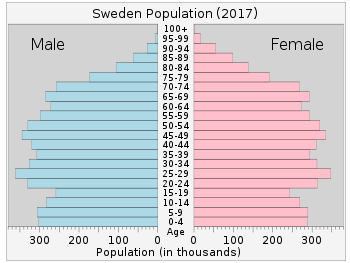
.jpg)
The total resident population of Sweden was 10,343,403 in March 2020.[10] The population exceeded 10 million for the first time on Friday 20 January 2017.[252][253] Every fourth (24,9%) resident in the country has immigrant background and every third (32,3%) has at least one parent born abroad.[20]
The average population density is just over 25 people per km² (65 per square mile), with 1 437 persons per km² in localities (continuous settlement with at least 200 inhabitants).[254],[255] 87% of the population live in urban areas, which cover 1.5% of the entire land area.[256] 63% of Swedes are in large urban areas.[256] It is substantially higher in the south than in the north. The capital city Stockholm has a municipal population of about 950,000 (with 1.5 million in the urban area and 2.3 million in the metropolitan area). The second- and third-largest cities are Gothenburg and Malmö. Greater Gothenburg counts just over a million inhabitants and the same goes for the western part of Scania, along the Öresund. The Öresund Region, the Danish-Swedish cross-border region around the Öresund that Malmö is part of, has a population of 4 million. Outside of major cities, areas with notably higher population density include the agricultural part of Östergötland, the western coast, the area around Lake Mälaren and the agricultural area around Uppsala.
Norrland, which covers approximately 60% of the Swedish territory, has a very low population density (below 5 people per square kilometre). The mountains and most of the remote coastal areas are almost unpopulated. Low population density exists also in large parts of western Svealand, as well as southern and central Småland. An area known as Finnveden, which is located in the south-west of Småland, and mainly below the 57th parallel, can also be considered as almost empty of people.
Between 1820 and 1930, approximately 1.3 million Swedes, a third of the country's population at the time, emigrated to North America, and most of them to the United States. There are more than 4.4 million Swedish Americans according to a 2006 US Census Bureau estimate.[257] In Canada, the community of Swedish ancestry is 330,000 strong.[258]
There are no official statistics on ethnicity, but according to Statistics Sweden, around 3,311,312 (32.3%) inhabitants of Sweden were of a foreign background in 2018, defined as being born abroad or born in Sweden with at least one parent born abroad.[259] The most common countries of origin were Syria (1.82%), Finland (1.45%), Iraq (1.41%), Poland (0.91%), Iran (0.76%) and Somalia (0.67%).[260] Sweden subsequently has one of the oldest populations in the world, with the average age of 41.1 years.[261]
Language
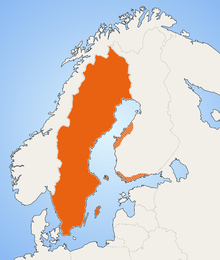
The official language of Sweden is Swedish,[14][15] a North Germanic language, related and very similar to Danish and Norwegian, but differing in pronunciation and orthography. Norwegians have little difficulty understanding Swedish, and Danes can also understand it, with slightly more difficulty than Norwegians. The same goes for standard Swedish speakers, who find it far easier to understand Norwegian than Danish. The dialects spoken in Scania, the southernmost part of the country, are influenced by Danish because the region traditionally was a part of Denmark and is nowadays situated closely to it. Sweden Finns are Sweden's largest linguistic minority, comprising about 5% of Sweden's population,[262] and Finnish is recognised as a minority language.[15] Owing to a 21st-century influx of native speakers of Arabic, the use of Arabic is likely more widespread in the country than that of Finnish. However, no official statistics are kept on language use.[263]
Along with Finnish, four other minority languages are also recognised: Meänkieli, Sami, Romani, and Yiddish. Swedish became Sweden's official language on 1 July 2009, when a new language law was implemented.[15] The issue of whether Swedish should be declared the official language had been raised in the past, and the Riksdag voted on the matter in 2005, but the proposal narrowly failed.[264]
In varying degrees, depending largely on frequency of interaction with English, a majority of Swedes, especially those born after World War II, understand and speak English, owing to trade links, the popularity of overseas travel, a strong Anglo-American influence and the tradition of subtitling rather than dubbing foreign television shows and films, and the relative similarity of the two languages which makes learning English easier. In a 2005 survey by Eurobarometer, 89% of Swedes reported the ability to speak English.[265]
English became a compulsory subject for secondary school students studying natural sciences as early as 1849, and has been a compulsory subject for all Swedish students since the late 1940s.[266] Depending on the local school authorities, English is currently a compulsory subject between first grade and ninth grade, with all students continuing in secondary school studying English for at least another year. Most students also study one and sometimes two additional languages. These include (but are not limited to) German, French and Spanish. Some Danish and Norwegian is at times also taught as part of Swedish courses for native speakers. Because of the extensive mutual intelligibility between the three continental Scandinavian languages Swedish speakers often use their native language when visiting or living in Norway or Denmark.
Religion
| Church of Sweden[267] | |||||||
| Year | Population | Church members | Percentage | ||||
|---|---|---|---|---|---|---|---|
| 1972 | 8,146,000 | 7,754,784 | 95.2% | ||||
| 1980 | 8,278,000 | 7,690,636 | 92.9% | ||||
| 1990 | 8,573,000 | 7,630,350 | 89.0% | ||||
| 2000 | 8,880,000 | 7,360,825 | 82.9% | ||||
| 2010 | 9,415,570 | 6,589,769 | 70.0% | ||||
| 2011 | 9,482,855 | 6,519,889 | 68.8% | ||||
| 2012 | 9,555,893 | 6,446,729 | 67.5% | ||||
| 2013 | 9,644,864 | 6,357,508 | 65.9% | ||||
| 2014 | 9,747,355 | 6,292,264 | 64.6%[268] | ||||
| 2015 | 9,850,452 | 6,225,091 | 63.2% | ||||
| 2016 | 9,995,153 | 6,116,480 | 61.2%[268] | ||||
| 2017 | 10 120 242 | 5 999 509 | 59.3%[269] | ||||
| 2018 | 10 230 185 | 5 904 830 | 57.7%[270] | ||||
Before the 11th century, Swedes adhered to Norse paganism, worshiping Æsir gods, with its centre at the Temple in Uppsala. With Christianisation in the 11th century, the laws of the country changed, forbidding worship of other deities until the late 19th century. After the Protestant Reformation in the 1530s, a change led by Martin Luther's Swedish associate Olaus Petri, the authority of the Roman Catholic Church was abolished and Lutheranism became widespread. Adoption of Lutheranism was completed by the Uppsala Synod of 1593, and it became the official religion. During the era following the Reformation, usually known as the period of Lutheran orthodoxy, small groups of non-Lutherans, especially Calvinist Dutchmen, the Moravian Church and French Huguenots played a significant role in trade and industry, and were quietly tolerated as long as they kept a low religious profile.[271] The Sami originally had their own shamanistic religion, but they were converted to Lutheranism by Swedish missionaries in the 17th and 18th centuries.
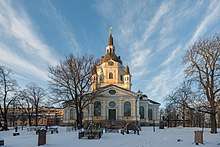
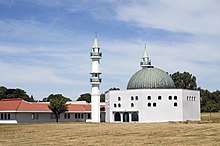
With religious liberalisations in the late 18th century believers of other faiths, including Judaism and Roman Catholicism, were allowed to live and work freely in the country. However, until 1860 it remained illegal for Lutherans to convert to another religion. The 19th century saw the arrival of various evangelical free churches, and, towards the end of the century, secularism, leading many to distance themselves from church rituals. Leaving the Church of Sweden became legal with the so-called dissenter law of 1860, but only under the provision of entering another Christian denomination. The right to stand outside any religious denomination was formally established in the law on freedom of religion in 1951.
In 2000, the Church of Sweden was disestablished. Sweden was the second Nordic country to disestablish its state church (after Finland did so in the Church Act of 1869).[272]
At the end of 2018, 57.7% of Swedes belonged to the Church of Sweden; this number had been decreasing by about 1.5 percentage points a year for the previous 7 years and one percentage point a year on average for the previous two decades.[270][273][274][275] Approximately 2% of the church's members regularly attend Sunday services.[276] The reason for the large number of inactive members is partly that, until 1996, children automatically became members at birth if at least one of the parents was a member. Since 1996, only children and adults who are christened become members. Some 275,000 Swedes are today members of various Evangelical Protestant free churches (where congregation attendance is much higher), and due to recent immigration, there are now some 100,000 Eastern Orthodox Christians and 92,000 Roman Catholics living in Sweden.[277]
The first Muslim congregation was established in 1949, when a small contingent of Tatars migrated from Finland. Islam's presence in Sweden remained marginal until the 1960s, when Sweden started to receive migrants from the Balkans and Turkey. Further immigration from North Africa and the Middle East have brought the estimated Muslim population to 600,000.[278] However, only about 110,000 were members of a congregation around 2010.[279][280][281]
According to the Eurobarometer Poll 2010,[282]
- 18% of Swedish citizens responded that "they believe there is a god".
- 45% answered that "they believe there is some sort of spirit or life force".
- 34% answered that "they do not believe there is any sort of spirit, god, or life force".
According to a Demoskop study in 2015 about the beliefs of the Swedish showed that
- 21% believed in a god (down from 35 percent in 2008).
- 16% believed in ghosts.
- 14% believed in creationism or intelligent design.[283][284]
Sociology professor Phil Zuckerman claims that Swedes, despite a lack of belief in God, commonly question the term atheist, preferring to call themselves Christians while being content with remaining in the Church of Sweden.[285] Religion continues to play a role in Swedish cultural identity.[286] This is evidenced by the fact that the majority of Swedish adults continue to remain members of the Lutheran Church despite having to pay a church tax; moreover, rates of baptism remain high and church weddings are increasing in Sweden.[286]
Health
Healthcare in Sweden is similar in quality to other developed nations. Sweden ranks in the top five countries with respect to low infant mortality. It also ranks high in life expectancy and in safe drinking water. A person seeking care first contacts a clinic for a doctor's appointment, and may then be referred to a specialist by the clinic physician, who may in turn recommend either in-patient or out-patient treatment, or an elective care option. The health care is governed by the 21 landsting of Sweden and is mainly funded by taxes, with nominal fees for patients.
Education
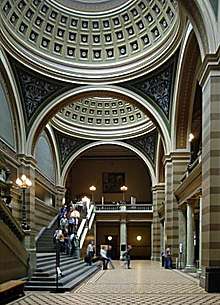
Children aged 1–5 years old are guaranteed a place in a public kindergarten (Swedish: förskola or, colloquially, dagis). Between the ages of 6 and 16, children attend compulsory comprehensive school. In the Programme for International Student Assessment (PISA), Swedish 15-year-old pupils score close to the OECD average.[287] After completing the 9th grade, about 90% of the students continue with a three-year upper secondary school (gymnasium), which can lead to both a job qualification or entrance eligibility to university. The school system is largely financed by taxes.
The Swedish government treats public and independent schools equally[288] by introducing education vouchers in 1992 as one of the first countries in the world after the Netherlands. Anyone can establish a for-profit school and the municipality must pay new schools the same amount as municipal schools get. School lunch is free for all students in Sweden, and providing breakfast is also encouraged.[289]
There are a number of different universities and colleges in Sweden, the oldest and largest of which are situated in Uppsala, Lund, Gothenburg and Stockholm. In 2000, 32% of Swedish people held a tertiary degree, making the country 5th in the OECD in that category.[290] Along with several other European countries, the government also subsidises tuition of international students pursuing a degree at Swedish institutions, although a recent bill passed in the Riksdag will limit this subsidy to students from EEA countries and Switzerland.[291]
The large influx of immigrants to Swedish schools has been cited as a significant part of the reason why Sweden has dropped more than any other European country in the international PISA rankings.[292][293][294][295]
Immigration
Immigration has been a major source of population growth and cultural change throughout much of the history of Sweden, and in recent centuries the country has been transformed from a nation of net emigration, ending after World War I, to a nation of net immigration, from World War II onwards. The economic, social, and political aspects of immigration have caused controversy regarding ethnicity, economic benefits, jobs for non-immigrants, settlement patterns, impact on upward social mobility, crime, and voting behaviour.[296]
There are no exact numbers on the ethnic background of migrants and their descendants in Sweden because the Swedish government does not base any statistics on ethnicity. This is, however, not to be confused with the migrants' national backgrounds, which are recorded.
In 2019, there were 2,634,967 inhabitants of a foreign background (foreign-born and children of international migrants), comprising around 25% of the Swedish population.[20] The number of people with at least one foreign parent was 3,415,166 which counts for 33% of the population.[297] Of these inhabitants, 2,019,733 persons living in Sweden were born abroad. In addition, 615,234 persons were born in Sweden to two parents born abroad and 780,199 persons had one parent born abroad with the other parent born in Sweden.[297]
Immigrants in Sweden are mostly concentrated in the urban areas of Svealand and Götaland.[298] Since the early 1970s, immigration to Sweden has been mostly due to refugee migration and family reunification from countries in the Middle East and Latin America.[299] In 2019, Sweden granted 21,958 people asylum, and 21,502 in 2018.[300]
The ten largest groups of foreign-born persons in the Swedish civil registry in 2019 were from:[301]





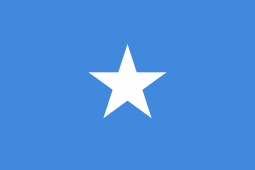
.svg.png)



According to an official investigation by The Swedish Pensions Agency on order from the government, the immigration to Sweden will double the state's expenses for pensions to the population. The total immigration to Sweden for 2017 will be roughly 180 000 people, and after that 110 000 individuals every year.[302][303]
Crime
Figures from the 2013 Swedish Crime Survey (SCS) show that exposure to crime decreased from 2005 to 2013.[304] Since 2014 there has been an increase in exposure to some categories of crimes, including fraud, some property crime and especially sexual offences (with a 70% increase since 2013, which was partly caused by laws broadening the definition of rape [305]) according to the 2016 SCS.[306] Violence (both lethal and non-lethal) has been on a downward trend the last 25 years.[307] The figures for fraud and property damage (excluding car theft) are in contrast with the numbers of reported crimes under such categories which have remained roughly constant over the period 2014–16.[308] The number of reported sexual offences clearly reflect the figures in the 2016 SCS, and car related damages/theft are also somewhat reflected.[309][310] The number of convictions up to 2013 has remained between 110,000 and 130,000 in the 2000s — a decrease since the 1970s, when they numbered around 300,000 — despite the population growth.[311] Consistent with other Western countries in the postwar era, the number of reported crimes has increased when measured from the 1950s; which can be explained by a number of factors, such as immigration, statistical and legislative changes and increased public willingness to report crime.[312]
Culture
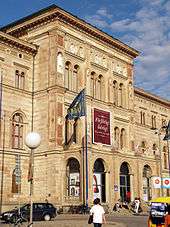
Sweden has many authors of worldwide recognition including August Strindberg, Astrid Lindgren, and Nobel Prize winners Selma Lagerlöf and Harry Martinson. In total seven Nobel Prizes in Literature have been awarded to Swedes. The nation's most well-known artists are painters such as Carl Larsson and Anders Zorn, and the sculptors Tobias Sergel and Carl Milles.
Swedish 20th-century culture is noted by pioneering works in the early days of cinema, with Mauritz Stiller and Victor Sjöström. In the 1920s–1980s, the filmmaker Ingmar Bergman and actors Greta Garbo and Ingrid Bergman became internationally noted people within cinema. More recently, the films of Lukas Moodysson, Lasse Hallström, and Ruben Östlund have received international recognition.
Throughout the 1960s and 1970s Sweden was seen as an international leader in what is now referred to as the "sexual revolution", with gender equality having particularly been promoted.[313] The early Swedish film I Am Curious (Yellow) (1967) reflected a liberal view of sexuality, including scenes of love making that caught international attention, and introduced the concept of the "Swedish sin" that had been introduced earlier in the US with Ingmar Bergman's Summer with Monika.
The image of "hot love and cold people" emerged. Sexual liberalism was seen as part of modernisation process that by breaking down traditional borders would lead to the emancipation of natural forces and desires.[314]
Sweden has also become very liberal towards homosexuality, as is reflected in the popular acceptance of films such as Show Me Love, which is about two young lesbians in the small Swedish town of Åmål. Since 1 May 2009, Sweden repealed its "registered partnership" laws and fully replaced them with gender-neutral marriage,[315] Sweden also offers domestic partnerships for both same-sex and opposite-sex couples. Cohabitation (sammanboende) by couples of all ages, including teenagers as well as elderly couples, is widespread. As of 2009, Sweden is experiencing a baby boom.[316]
Music
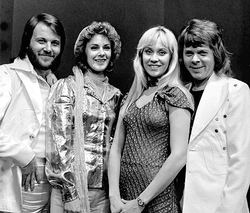
Historical re-creations of Norse music have been attempted based on instruments found in Viking sites. The instruments used were the lur (a sort of trumpet), simple string instruments, wooden flutes and drums. Sweden has a significant folk-music scene. There is Sami music, called the joik, which is a type of chant which is part of the traditional Sami animistic spirituality. Notable composers include Carl Michael Bellman and Franz Berwald.
Sweden also has a prominent choral music tradition. Out of a population of 9.5 million, it is estimated that five to six hundred thousand people sing in choirs.[317]
In 2007, with over 800 million dollars in revenue, Sweden was the third-largest music exporter in the world and surpassed only by the US and the UK.[318][319] According to one source 2013, Sweden produces the most chart hits per capita in the world, followed by the UK and the USA.[320] Sweden has a rather lively jazz scene. During the last sixty years or so it has attained a remarkably high artistic standard, stimulated by domestic as well as external influences and experiences. The Centre for Swedish Folk Music and Jazz Research has published an overview of jazz in Sweden by Lars Westin.[321]
Architecture
Before the 13th century almost all buildings were made of timber, but a shift began towards stone. Early Swedish stone buildings are the Romanesque churches on the country side. As so happens, many of them were built in Scania and are in effect Danish churches. This would include the Lund Cathedral from the 11th century and the somewhat younger church in Dalby, but also many early Gothic churches built through influences of the Hanseatic League, such as in Ystad, Malmö and Helsingborg.
Cathedrals in other parts of Sweden were also built as seats of Sweden's bishops. The Skara Cathedral is of bricks from the 14th century, and the Uppsala Cathedral in the 15th. In 1230 the foundations of the Linköping Cathedral were made, the material was there limestone, but the building took some 250 years to finish.
Among older structures are also some significant fortresses and other historical buildings such as at Borgholm Castle, Halltorps Manor and Eketorp fortress on the island Öland, the Nyköping fortress and the Visby city wall.
Around 1520 Sweden was out of the Middle Ages and united under King Gustav Vasa, who immediately initiated grand mansions, castles and fortresses to be built. Some of the more magnificent include Kalmar Castle, Gripsholm Castle and the one at Vadstena.
In the next two centuries, Sweden was designated by Baroque architecture and later the rococo. Notable projects from that time include the city Karlskrona, which has now also been declared a World Heritage Site and the Drottningholm Palace.
1930 was the year of the great Stockholm exhibition, which marked the breakthrough of Functionalism, or "funkis" as it became known. The style came to dominate in the following decades. Some notable projects of this kind were the Million Programme, offering affordable living in large apartment complexes.
The Ericsson Globe is the largest hemispherical building on Earth, Shaped like a large white ball, and took two and a half years to build. It's located in Stockholm.
Media
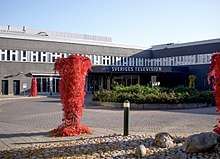
Swedes are among the greatest consumers of newspapers in the world, and nearly every town is served by a local paper. The country's main quality morning papers are Dagens Nyheter (liberal), Göteborgs-Posten (liberal), Svenska Dagbladet (liberal conservative) and Sydsvenska Dagbladet (liberal). The two largest evening tabloids are Aftonbladet (social democratic) and Expressen (liberal). The ad-financed, free international morning paper, Metro International, was founded in Stockholm, Sweden. The country's news is reported in English by, among others, The Local (liberal).[322]
The public broadcasting companies held a monopoly on radio and television for a long time in Sweden. Licence funded radio broadcasts started in 1925. A second radio network was started in 1954 and a third opened 1962 in response to pirate radio stations. Non-profit community radio was allowed in 1979 and in 1993 commercial local radio started.
The licence-funded television service was officially launched in 1956. A second channel, TV2, was launched in 1969. These two channels (operated by Sveriges Television since the late 1970s) held a monopoly until the 1980s when cable and satellite television became available. The first Swedish language satellite service was TV3 which started broadcasting from London in 1987. It was followed by Kanal 5 in 1989 (then known as Nordic Channel) and TV4 in 1990.
In 1991 the government announced it would begin taking applications from private television companies wishing to broadcast on the terrestrial network. TV4, which had previously been broadcasting via satellite, was granted a permit and began its terrestrial broadcasts in 1992, becoming the first private channel to broadcast television content from within the country.
Around half the population are connected to cable television. Digital terrestrial television in Sweden started in 1999 and the last analogue terrestrial broadcasts were terminated in 2007.
Literature
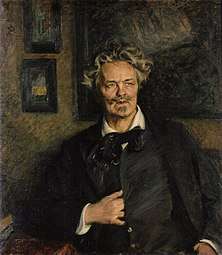
The first literary text from Sweden is the Rök runestone, carved during the Viking Age c. 800 AD. With the conversion of the land to Christianity around 1100 AD, Sweden entered the Middle Ages, during which monastic writers preferred to use Latin. Therefore, there are only a few texts in the Old Swedish from that period. Swedish literature only flourished when the Swedish language was standardised in the 16th century, a standardisation largely due to the full translation of the Bible into Swedish in 1541. This translation is the so-called Gustav Vasa Bible.
With improved education and the freedom brought by secularisation, the 17th century saw several notable authors develop the Swedish language further. Some key figures include Georg Stiernhielm (17th century), who was the first to write classical poetry in Swedish; Johan Henric Kellgren (18th century), the first to write fluent Swedish prose; Carl Michael Bellman (late 18th century), the first writer of burlesque ballads; and August Strindberg (late 19th century), a socio-realistic writer and playwright who won worldwide fame. The early 20th century continued to produce notable authors, such as Selma Lagerlöf, (Nobel laureate 1909), Verner von Heidenstam (Nobel laureate 1916) and Pär Lagerkvist (Nobel laureate 1951).
In recent decades, a handful of Swedish writers have established themselves internationally, including the detective novelist Henning Mankell and the writer of spy fiction Jan Guillou. The Swedish writer to have made the most lasting impression on world literature is the children's book writer Astrid Lindgren, and her books about Pippi Longstocking, Emil, and others. In 2008, the second best-selling fiction author in the world was Stieg Larsson, whose Millennium series of crime novels is being published posthumously to critical acclaim.[323] Larsson drew heavily on the work of Lindgren by basing his central character, Lisbeth Salander, on Longstocking.[324]
Holidays
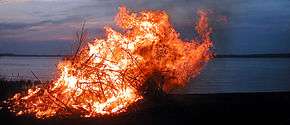
Apart from traditional Protestant Christian holidays, Sweden also celebrates some unique holidays, some of a pre-Christian tradition. They include Midsummer celebrating the summer solstice; Walpurgis Night (Valborgsmässoafton) on 30 April lighting bonfires; and Labour Day or Mayday on 1 May is dedicated to socialist demonstrations. The day of giver-of-light Saint Lucia, 13 December, is widely acknowledged in elaborate celebrations which betoken its Italian origin and commence the month-long Christmas season.
6 June is the National Day of Sweden and has since 2005 been a public holiday. Furthermore, there are official flag day observances and a Namesdays in Sweden calendar. In August many Swedes have kräftskivor (crayfish dinner parties). Martin of Tours Eve is celebrated in Scania in November with Mårten Gås parties, where roast goose and svartsoppa ('black soup', made of goose stock, fruit, spices, spirits and goose blood) are served. The Sami, one of Sweden's indigenous minorities, have their holiday on 6 February and Scania celebrate their Scanian Flag day on the third Sunday in July.[325]
Cuisine
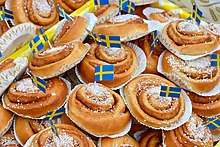

Swedish cuisine, like that of the other Scandinavian countries (Denmark, Norway and Finland), was traditionally simple. Fish (particularly herring), meat, potatoes and dairy products played prominent roles. Spices were sparse. Preparations include Swedish meatballs, traditionally served with gravy, boiled potatoes and lingonberry jam; pancakes; lutfisk; and the smörgåsbord, or lavish buffet. Akvavit is a popular alcoholic distilled beverage, and the drinking of snaps is of cultural importance. The traditional flat and dry crisp bread has developed into several contemporary variants. Regionally important foods are the surströmming (a fermented fish) in northern Sweden and eel in Scania in southern Sweden.
Swedish traditional dishes, some of which are many hundreds of years old, are still an important part of Swedish everyday meals, in spite of the fact that modern-day Swedish cuisine adopts many international dishes.
In August, at the traditional feast known as crayfish party, kräftskiva, Swedes eat large amounts of crayfish boiled with dill.
Cinema
Swedes have been fairly prominent in the film area through the years. A number of Swedish people have found success in Hollywood, including Ingrid Bergman, Greta Garbo and Max von Sydow. Amongst several directors who have made internationally successful films can be mentioned Ingmar Bergman, Lukas Moodysson and Lasse Hallström.
Fashion
Interest in fashion is big in Sweden and the country is headquartering famous brands like Hennes & Mauritz (operating as H&M), J. Lindeberg (operating as JL), Acne, Lindex, Odd Molly, Cheap Monday, Gant, WESC, Filippa K, and Nakkna within its borders. These companies, however, are composed largely of buyers who import fashionable goods from throughout Europe and America, continuing the trend of Swedish business toward multinational economic dependency like many of its neighbours.
Sports
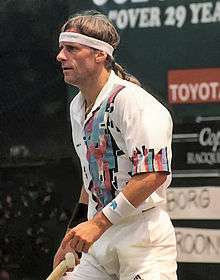
Sport activities are a national movement with half of the population actively participating in organised sporting activities. The two main spectator sports are football and ice hockey. Second to football, horse sports (of which most of the participants are women) have the highest number of practitioners. Thereafter, golf, orienteering, gymnastics, track and field, and the team sports of ice hockey, handball, floorball, basketball and bandy are the most popular in terms of practitioners.[326]
The Swedish national men's ice hockey team, affectionately known as Tre Kronor (English: Three Crowns; the national symbol of Sweden), is regarded as one of the best in the world. The team has won the World Championships nine times, placing them third in the all-time medal count. Tre Kronor also won Olympic gold medals in 1994 and 2006. In 2006, Tre Kronor became the first national hockey team to win both the Olympic and world championships in the same year. The Swedish national football team has seen some success at the World Cup in the past, finishing second when they hosted the tournament in 1958, and third twice, in 1950 and 1994. Athletics has enjoyed a surge in popularity due to several successful athletes in recent years, such as Carolina Klüft and Stefan Holm.
Sweden hosted the 1912 Summer Olympics, Equestrian at the 1956 Summer Olympics and the FIFA World Cup in 1958. Other big sports events include the UEFA Euro 1992, 1995 FIFA Women's World Cup, 1995 World Championships in Athletics, UEFA Women's Euro 2013, and several championships of ice hockey, curling, athletics, skiing, bandy, figure skating and swimming.
Successful football players include Gunnar Nordahl, Gunnar Gren, Nils Liedholm, Henrik Larsson, Freddie Ljungberg, Caroline Seger, Lotta Schelin, Hedvig Lindahl, and Zlatan Ibrahimović. Successful tennis players include former world number 1 players Björn Borg, Mats Wilander and Stefan Edberg. Other famous Swedish athletes include the heavyweight boxing champion and International Boxing Hall of Famer Ingemar Johansson, World Golf Hall of Famer Annika Sörenstam, and multiple World Championships and Olympics medalist in table tennis Jan-Ove Waldner. Due to its northerly latitude numerous world class winter sports athletes have come from Sweden. This includes alpine skiers Ingemar Stenmark, Anja Pärson and Pernilla Wiberg as well as cross country-skiers Gunde Svan, Thomas Wassberg, Charlotte Kalla and Marcus Hellner, all Olympic gold medalists.
In 2016, The Swedish Poker Federation (Svepof) has joined The International Federation of Poker (IFP).[327]
International rankings
The following are links to international rankings of Sweden from selected research institutes and foundations including economic output and various composite indices.
| Index | Rank | Countries reviewed |
|---|---|---|
| WIN/GIA 2015 End of Year Report, Economic Pessimism[328] | 4th | 68 |
| Climate Change Performance Index 2018[329] | 4th (no countries received rankings one to three) | 60 |
| Index of Economic Freedom 2018[330] | 15th | 180 |
| Ease of Doing Business Index 2017[331] | 10th | 190 |
| EF English Proficiency Index 2017[332] | 2nd | 80 |
| Logistics Performance Index 2016[333] | 3rd | 160 |
| Inequality adjusted Human Development Index 2019 | 8th | 189 |
| Corruption Perceptions Index 2017[334] | 6th | 180 |
| Globalization Index 2015 | 4th | 207 |
| Human Development Index 2019[335] | 8th | 189 |
| United Nations World Happiness Report 2018[336] | 9th | 156 |
Notes
- The Monarch and dynastic members of the Royal House must at all times be a Protestant Christian of the Church of Sweden, but has not been the official state religion since the year 2000.[2][3][4] However, the Church is recognized by law[5] and is still supported by the state.[6]
- The State (Swedish: staten) is also descriptively translated into English as the "central government", not to be confused with the Government, i.e. the cabinet which is but one organ of the State.
- An alternate English translation is "local governments".
References
- "Mottoes of The Kings and Queens of Sweden". www.kungahuset.se. Royal Court of Sweden. Archived from the original on 23 December 2015. Retrieved 22 December 2015.
- "The Act of Succession". The Riksdag. Retrieved 24 October 2014.
- Nergelius: pp. 42–44.
- "Svenska kyrkan i siffror". Church of Sweden (Svenska kyrkan).
- ."SFS 1998:1591", Riksdagen
- "Church of Sweden". www.sweden.org.za. Retrieved 8 August 2020.
- https://www.indexmundi.com/sweden/religions.html
- "Religions in Sweden | PEW-GRF". www.globalreligiousfutures.org. Retrieved 8 August 2020.
- Norborg, Lars-Arne. "svensk–norska unionen". ne.se (in Swedish). Nationalencyklopedin. Archived from the original on 15 January 2016. Retrieved 6 August 2015.
- Population Statistics Sweden. Retrieved 20 February 2020.
- "World Economic Outlook Database, October 2019". IMF.org. International Monetary Fund. Retrieved 8 January 2020.
- "Gini coefficient of equivalised disposable income – EU-SILC survey". ec.europa.eu. Eurostat. Archived from the original on 20 March 2019. Retrieved 3 July 2020.
- "Human Development Report 2019" (PDF). United Nations Development Programme. 10 December 2019. Retrieved 10 December 2019.
- "Språklag (2009:600)" (in Swedish). Riksdag. 28 May 2009. Archived from the original on 10 November 2014. Retrieved 10 November 2014.
- Landes, David (1 July 2009). "Swedish becomes official 'main language'". The Local. Archived from the original on 10 December 2013. Retrieved 15 July 2009.
- "Är svenskan också officiellt språk i Sverige?" [Is Swedish also an official language in Sweden?] (in Swedish). Swedish Language Council. 1 February 2008. Archived from the original on 6 February 2014. Retrieved 22 June 2008.
- "Summary of Population Statistics 1960–2012". Statistics Sweden. Archived from the original on 17 March 2013. Retrieved 9 June 2013.
- Note that Swedish-speaking Finns or other Swedish-speakers born outside Sweden might identify as Swedish despite being born abroad. Moreover, people born in Sweden may not be ethnic Swedes. As the Swedish government does not base any statistics on ethnicity, there are no exact numbers on the ethnic background of migrants and their descendants in Sweden. This is not, however, to be confused with migrants' national backgrounds, which are recorded.
- The United Nations Group of Experts on Geographical Names states that the country's formal name is the Kingdom of Sweden. UNGEGN World Geographical Names, Sweden.
- "Number of persons by foreign/Swedish background and year". www.statistikdatabasen.scb.se. Archived from the original on 12 June 2018. Retrieved 23 March 2020.
- "Statistical database - Select variable and values". Statistikdatabasen.scb.se. 19 March 2020. Retrieved 3 June 2020.
- "Digerdöden – Historiska Museet". historiska.se. Archived from the original on 2 September 2017. Retrieved 1 September 2017.
- "Värre än forskarna anat: Digerdöden". 15 December 2012. Archived from the original on 2 September 2017. Retrieved 1 September 2017.
- "Artikelarkiv". SO-rummet. Archived from the original on 9 October 2017. Retrieved 1 September 2017.
- Birnbaum, Ben (2 December 2010). "WikiLeaks reveal Swedes gave intel on Russia, Iran". The Washington Times. Archived from the original on 21 July 2013. Retrieved 10 June 2013.
- Rundquist, Solveig (15 August 2014). "Sweden celebrates 200 years of peace". The Local. Retrieved 25 April 2020.
- "2013 Human Development Report" (PDF). United Nations Development Programme. Archived (PDF) from the original on 18 August 2013. Retrieved 28 July 2013.
- "OECD Better Life Index". OECD Publishing. Archived from the original on 1 September 2013. Retrieved 27 August 2013.
- "Global Competitiveness Report 2012–2013". World Economic Forum. 5 September 2012. Archived from the original on 10 December 2014. Retrieved 9 June 2013.
- "Sweden". Oxford English Dictionary (3rd ed.). Oxford University Press. September 2005. (Subscription or UK public library membership required.)
- Hellquist, Elof (1922). Svensk etymologisk ordbok [Swedish etymological dictionary] (in Swedish). Lund: Gleerup. p. 917. Archived from the original on 28 August 2011. Retrieved 30 August 2011.
- Hellquist, Elof (1922). Svensk etymologisk ordbok [Swedish etymological dictionary] (in Swedish). Lund: Gleerup. p. 915.
- Quoted from: Gwyn Jones. A History of the Vikings. Oxford University Press, 2001. ISBN 0-19-280134-1. Page 164.
- Sawyer, Birgit; Sawyer, Peter (1993). Medieval Scandinavia: from Conversion to Reformation, Circa 800–1500. University of Minnesota Press. pp. 150–153. ISBN 978-0-8166-1739-5.
- Bagge, Sverre (2005). "The Scandinavian Kingdoms". In McKitterick, Rosamond (ed.). The New Cambridge Medieval History. Cambridge University Press. p. 724. ISBN 978-0-521-36289-4.
Swedish expansion in Finland led to conflicts with Rus', which were temporarily brought to an end by a peace treaty in 1323, dividing the Karelian peninsula and the northern areas between the two countries.
- Ivars, Ann-Marie; Hulden, Lena, eds. (2002). När kom svenskarna till Finland?. Helsinki: Studier utg. av Svenska Litteratursällskapet i Finland 646.
- Meinander, Carl Fredrik (1983). Om svenskarnes inflyttningar till Finland. Historisk Tidskrift för Finland 3/1983.
- Tarkiainen, Kari (2008). Sveriges Österland: Från forntiden till Gustav Vasa. Finlands svenska historia 1. Skrifter utgivna av Svenska litteratursällskapet i Finland 702:1. Helsinki: Svenska litteratursällskapet i Finland; Stockholm: Atlantis.
- Scott, Franklin D. (1977). Sweden: The Nation's History. Minneapolis: University of Minnesota Press. p. 58.
- Westrin, Theodor, ed. (1920). Nordisk familjebok: konversationslexikon och realencyklopedi. Bd 30 (in Swedish) (New, rev. and richly ill. ed.). Stockholm: Nordisk familjeboks förl. pp. 159–160. Archived from the original on 20 June 2017. Retrieved 17 September 2014.
- Scott, p. 55.
- Scott, pp. 55–56.
- Scott, pp. 56–57.
- Scott, p. 121.
- Hoyt, Robert S.; Chodorow, Stanley (1976). Europe in the Middle Ages. New York: Harcourt, Brace & Jovanovich, Inc. p. 628.
- Wolfe, John B. (1962). The Emergence of European Civilization. New York: Harper & Row Pub. pp. 50–51.
- Scott, p. 52.
- Scott, p. 132.
- Scott, pp. 156–157.
- Worthington, David (15 January 2010). "British and Irish Emigrants and Exiles in Europe, 1603–1688". BRILL. Retrieved 3 June 2019 – via Google Books.
- "the cambridge modern history". CUP Archive. 3 June 2019. Retrieved 3 June 2019 – via Google Books.
- Davies, Norman (24 February 2005). "God's Playground A History of Poland: Volume 1: The Origins to 1795". OUP Oxford. Retrieved 3 June 2019 – via Google Books.
- Frost 2000, p. 102.
- Frost 2000, p. 103.
- "A Political and Social History of Modern Europe V.1./Hayes..." Hayes, Carlton J. H. (1882–1964), Title: A Political and Social History of Modern Europe V.1., 2002-12-08, Project Gutenberg, webpage: Infomot-7hsr110. Archived 17 November 2007 at the Wayback Machine
- However, Sweden's largest territorial extent lasted from 1319 to 1343 with Magnus Eriksson ruling all of the traditional lands of Sweden and Norway.
- "Gustav I Vasa – Britannica Concise" (biography), Britannica Concise, 2007, webpage: EBConcise-Gustav-I-Vasa.
- "Battle of Kircholm 1605". Kismeta.com. Archived from the original on 14 June 2009. Retrieved 25 August 2010.
- "Finland and the Swedish Empire". Library of Congress Country Studies. Archived from the original on 26 December 2016. Retrieved 17 September 2014.
- Ewan, Elizabeth; Nugent, Janay (2008). Finding the family in medieval and early modern Scotland. Ashgate Publishing. p. 153. ISBN 978-0-7546-6049-1. Archived from the original on 5 September 2015. Retrieved 1 July 2015.
- Frost 2000, p. 156.
- Frost 2000, p. 216.
- Frost 2000, p. 222.
- Frost 2000, p. 232.
- Frost 2000, p. 230.
- Frost 2000, p. 272.
- Frost 2000, p. 290.
- Frost 2000, p. 286.
- Frandsen, Karl-Erik (2009). The Last Plague in the Baltic Region. 1709–1713. Copenhagen. p. 80.
- Engström, Nils Göran (1994). "Pesten i Finland 1710" [The plague in Finland in 1710]. Hippokrates. Suomen Lääketieteen Historian Seuran vuosikirja. 11: 38. PMID 11640321.
- Frost 2000, p. 295.
- Frost 2000, p. 296.
- Ericson, Lars (2004). Svenska knektar (in Swedish). Lund: Historiska media. p. 92.
- Jutikkala, Eino; Pirinen, Kauko (2003). A History of Finland. Helsinki. p. 287. ISBN 951-0-27911-0.
- Schäfer, Anton (2002). Zeittafel der Rechtsgeschichte. Von den Anfängen über Rom bis 1919. Mit Schwerpunkt Österreich und zeitgenössischen Bezügen (in German) (3 ed.). Edition Europa Verlag. p. 137. ISBN 3-9500616-8-1.
- Ottosen, Morten Nordhagen (25 November 2015). "Mossekonvensjonen". Norges historie (in Norwegian). University of Oslo. Retrieved 9 December 2019.
- "Sweden and Norway celebrate peace treaty". The Local Europe AB. 14 August 2014. Retrieved 9 December 2019.
- Tore Frängsmyr, "Ostindiska Kompaniet", Publisher- "Bokförlaget Bra Böcker", Höganäs, 1976. (No ISBN to be found), backside overview and
- Magocsi, Paul Robert, ed. (1998). Encyclopedia of Canada's Peoples. University of Minnesota Press. p. 1220. ISBN 978-0-8020-2938-6.
- Einhorn, Eric; Logue, John (1989). Modern Welfare States: Politics and Policies in Social Democratic Scandinavia. Praeger Publishers. p. 9. ISBN 978-0275931889.
Though Denmark, where industrialization had begun in the 1850s, was reasonably prosperous by the end of the nineteenth century, both Sweden and Norway were terribly poor. Only the safety valve of mass emigration to America prevented famine and rebellion. At the peak of emigration in the 1880s, over 1% of the total population of both countries emigrated annually.
- Koblik, Steven (1975). Sweden's Development From Poverty to Affluence, 1750–1970. University of Minnesota Press. pp. 8–9. ISBN 978-0816607662.
In economic and social terms the eighteenth century was more a transitional than a revolutionary period. Sweden was, in light of contemporary Western European standards, a relatively poor but stable country. ...It has been estimated that 75–80% of the population was involved in agricultural pursuits during the late eighteenth century. One hundred years later, the corresponding figure was still 72%.
- Einhorn, Eric and John Logue (1989), p. 8.
- Ulf Beijbom, "European emigration", The House of Emigrants, Växjö, Sweden Archived 3 August 2008 at the Wayback Machine
- Koblik, pp. 9–10.
- "Sweden: Social and economic conditions (2007)". Britannica.com. Archived from the original on 30 May 2008. Retrieved 19 February 2007.
- Koblik, p. 11: "The agrarian revolution in Sweden is of fundamental importance for Sweden's modern development. Throughout Swedish history the countryside has taken an unusually important role in comparison with other European states."
- Koblik, p. 90. "It is usually suggested that between 1870 and 1914 Sweden emerged from its primarily agrarian economic system into a modern industrial economy."
- Siney, Marion C. (1975). "Swedish neutrality and economic warfare in World War I". Conspectus of History. 1 (2).
- Koblik, pp. 303–313.
- Nordstrom, p. 315: "Sweden's government attempted to maintain at least a semblance of neutrality while it bent to the demands of the prevailing side in the struggle. Although effective in preserving the country's sovereignty, this approach generated criticism at home from many who believed the threat to Sweden was less serious than the government claimed, problems with the warring powers, ill feelings among its neighbours, and frequent criticism in the postwar period."
- Nordstrom, pp. 313–319.
- Zubicky, Sioma (1997). Med förintelsen i bagaget (in Swedish). Stockholm: Bonnier Carlsen. p. 122. ISBN 978-91-638-3436-3.
- "Raoul Wallenberg". Jewishvirtuallibrary.org. Archived from the original on 5 December 2014. Retrieved 28 August 2014.
- Nordstrom, pp. 335–339.
- Globalization and Taxation: Challenges to the Swedish Welfare State. By Sven Steinmo.
- "Finland: Now, the Seven and a Half". Time. 7 April 1961. Archived from the original on 4 November 2011. Retrieved 18 July 2009.
- Nordstrom, p. 344: "During the last 25 years of the century a host of problems plagued the economies of Norden and the West. Although many were present before, the 1973 and 1980 global oil crises acted as catalysts in bringing them to the fore."
- Krantz, Olle; Schön, Lennart (2007). Swedish Historical National Accounts, 1800–2000. Lund: Almqvist and Wiksell International.
- Englund, P. 1990. "Financial deregulation in Sweden." European Economic Review 34 (2–3): 385–393. Korpi TBD. Meidner, R. 1997. "The Swedish model in an era of mass unemployment." Economic and Industrial Democracy 18 (1): 87–97. Olsen, Gregg M. 1999. "Half empty or half full? The Swedish welfare state in transition." Canadian Review of Sociology & Anthropology, 36 (2): 241–268.
- "Sweden's 'Crazy' 500% Interest Rate; Fails to Faze Most Citizens, Businesses; Hike Seen as Short-Term Move to Protect Krona From Devaluation". Highbeam.com. 18 September 1992. Archived from the original on 15 February 2011. Retrieved 3 August 2010.
- Jonung, Lars; Kiander, Jaakko; Vartia, Pentti (2009). The Great Financial Crisis in Finland and Sweden. Edward Elgar Publishing. ISBN 978-1-84844-305-1. Archived from the original on 5 September 2015. Retrieved 1 July 2015.
- "New Swedish weapon in Iraq". The Local. 7 February 2006. Archived from the original on 29 April 2013. Retrieved 10 June 2013.
- "Rioting breaks out in Malmö suburb". The Local. Archived from the original on 26 July 2013. Retrieved 30 June 2013.
- "Fires and rioting after Malmö suburb unrest". The Local. Archived from the original on 5 February 2013. Retrieved 30 June 2013.
- "Sweden Riots Put Faces to Statistics as Stockholm Burns". Bloomberg News. Archived from the original on 8 July 2013. Retrieved 30 June 2013.
- Higgins, Andrew (26 May 2013). "In Sweden, Riots Put an Identity in Question". The New York Times. Archived from the original on 31 May 2013. Retrieved 1 June 2013.
- "Sweden parties reach budget deal to avoid snap election". BBC News. 27 December 2014. Archived from the original on 6 January 2016. Retrieved 9 January 2016.
- Bilefsky, Dan (5 January 2016). "Sweden and Denmark add border controls to stem flows of migrants". The New York Times. Archived from the original on 7 January 2016. Retrieved 9 January 2016.
- "Immigration: Sweden rolls back strict rules on family reunification". 19 June 2019. Retrieved 7 August 2019.
- "Country Comparison: Area". Central Intelligence Agency. Cia.gov. Archived from the original on 2 June 2010. Retrieved 19 August 2010.
- "Göta kanal official website". Göta Canal. Archived from the original on 12 January 2016. Retrieved 9 January 2016.
- "BBC Climate and the Gulf Stream". BBC. Archived from the original on 28 September 2008. Retrieved 29 October 2008.
- Watts, Harvey Maitland (1900). "The Gulf Stream Myth". Monthly Weather Review. 28 (9): 393–394. Bibcode:1900MWRv...28..393W. doi:10.1175/1520-0493(1900)28[393:TGSM]2.0.CO;2. Archived from the original on 25 February 2011. Retrieved 29 October 2008.
- "Global Climate Maps". Food and Agriculture Organization. Archived from the original on 17 November 2006.
- "Normal solskenstid för ett år" (in Swedish). Swedish Meteorological and Hydrological Institute. Archived from the original on 26 August 2010. Retrieved 27 January 2010.
- as can be seen in the table below which relies on SMHI official data for the latest fixed 30-year period, 1961 to 1990
- "Weather Data: Sweden, Vuoggatjalme, 1966, February". geographic.org. Retrieved 27 June 2020.
- "Precipitation, Sunshine & Radiation for January 2015 (all-time records section)" (PDF) (in Swedish). Swedish Meteorological and Hydrological Institute. Archived (PDF) from the original on 15 January 2016. Retrieved 31 October 2015.
- "Temperature & Wind – January 2015 (all-time records section)" (PDF) (in Swedish). Swedish Meteorological and Hydrological Institute. Archived (PDF) from the original on 15 January 2016. Retrieved 31 October 2015.
- "Tropiska nätter" [Tropical nights] (in Swedish). Swedish Meteorological and Hydrological Institute. Archived from the original on 4 March 2016. Retrieved 9 January 2016.
- The weather stations' names and numbers are first found at "Archived copy" (PDF). Archived (PDF) from the original on 3 March 2016. Retrieved 12 May 2015.CS1 maint: archived copy as title (link)
- "Average Temperatures for each Months and Annual Average". Archived from the original on 9 October 2013.
- "Södra lövskogsregionen – Skogskunskap". www.skogskunskap.se. Archived from the original on 12 October 2017. Retrieved 11 October 2017.
- "Forest and Buildings". lansstyrelsen.se (in Swedish). Archived from the original on 12 October 2017.
Granskogen, som spreds norrifrån, nådde inte Skåne förrän mot slutet av 1800-talet. Under 1900-talets första hälft planterades stora arealer granskog." or in English "The spruce forest, which spread from the north, did not reach Scania until the end of the 19th century. During the first half of the twentieth century, large areas of pine forest were planted.
- "Summary in English PDF, page 8 at".
- "Skogen växer bättre – men riskerna blir fler". www.skogsstyrelsen.se. Archived from the original on 12 October 2017. Retrieved 11 October 2017.
- Quote from Sydsvenska Dagbladet, section "2" at Archived 12 October 2017 at the Wayback Machine,"Efter stormen kritiserades skogsägarna för att de dominerande granskogarna gjorde att stormen tog hårdare. Uppblandning med lövträd gör skog stryktåligare" or in English "After the storm, the spruce and pine forest owners were criticized for the domination of the forests that made the storm tougher. Admixture with hardwood makes forest more stringent"
- Dagens Nyheter about the same. Archived 12 October 2017 at the Wayback Machine
- About the 1984 "Ädellövskogslagen" Archived 12 October 2017 at the Wayback Machine – "I Sydsverige (Skåne, Halland och Blekinge) skall minst 70% av beståndet utgöras av ädellöv. Enligt ädellövskogslagen skall efter slutavverkning, alltid ny ädellövskog anläggas på sådana marker." or "In southern Sweden (Scania, Halland and Blekinge) at least 70% of the stock must be of edible leaves. According to the 'edible deciduous forests law', after ever harvesting, new deciduous forests must always be planted on such fields." (in these three provinces)
- "Södra barrskogsregionen – Skogskunskap". www.skogskunskap.se. Archived from the original on 13 October 2017. Retrieved 13 October 2017.
- Swedish Encyclopedia "Bonniers Lexikon", vol 13 of 15, article "Sverige", Sweden, columns 1046–1050
- "The Constitution". The Riksdag. Archived from the original on 10 November 2014. Retrieved 8 November 2014.
- Petersson: pp. 38–40.
- Larsson & Bäck: pp. 16–18.
- Larsson & Bäck: pp. 212–215.
- Petersson: p. 92.
- Petersson: p. 174.
- Petersson: p. 79.
- Larsson & Bäck: p. 210.
- Petersson: pp. 79–82.
- Petersson: pp. 80–82.
- "Monarchy: A modern royal family". Sweden.se. Archived from the original on 25 April 2013. Retrieved 13 March 2013.
- "The Instrument of Government". The Riksdag. Archived from the original on 24 October 2014. Retrieved 8 November 2014.
- "The Head of State". Government of Sweden. Archived from the original on 25 February 2014. Retrieved 8 November 2014.
- "Duties of the Monarch". Royal Court of Sweden. Archived from the original on 16 March 2015. Retrieved 8 November 2014.
- "A new government is formed". The Riksdag. Archived from the original on 9 November 2014. Retrieved 8 November 2014.
- "Annual Report 2012" (PDF). Royal Court of Sweden. Archived (PDF) from the original on 4 June 2014. Retrieved 8 November 2014.
- "The Riksdag Act – almost a fundamental law". The Riksdag. Archived from the original on 24 October 2014. Retrieved 9 November 2014.
- "The Swedish Government Offices – a historical perspective". Government Offices of Sweden. Archived from the original on 24 October 2014. Retrieved 8 November 2014.
- "Forming a government". The Riksdag. Archived from the original on 9 October 2014. Retrieved 8 November 2014.
- "The Instrument of Government (as of 2012)" (PDF). The Riksdag. Archived (PDF) from the original on 8 October 2014. Retrieved 8 November 2014.
- "The Swedish courts". Swedish National Courts Administration. 27 November 2005. Archived from the original on 19 October 2014. Retrieved 9 November 2014.
- Terrill 2009, p. 243.
- Terrill 2009, p. 246.
- "Center–right wins Swedish election — but short of majority". Sveriges Radio International/Radio Sweden. 20 September 2010. Archived from the original on 11 May 2012.
- The Official Website of the Swedish Election Authority. "Val till riksdagen". Election Authority. Archived from the original on 9 August 2007. Retrieved 18 August 2007.
- "Beslut 2014-09-20" (PDF) (in Swedish). Election Authority. Archived (PDF) from the original on 24 September 2014. Retrieved 8 November 2014.
- "Sweden's new Government". Government Offices of Sweden. Archived from the original on 6 October 2014. Retrieved 8 November 2014.
- "Change of Government Council at the Royal Palace of Stockholm". Royal Court of Sweden. Archived from the original on 8 November 2014. Retrieved 8 November 2014.
- "Röster – Val 2014" (in Swedish). Election Authority. Archived from the original on 3 May 2015. Retrieved 15 February 2016.
- "Röster - Val 2018". data.val.se. Retrieved 18 January 2019.
- Holmberg, Sören (1999). Norris, Pippa (ed.). Critical Citizens: Global Support for Democratic Government. Oxford University Press. pp. 103–123. ISBN 978-0-19-829568-6.
- Swedish Association of Local Authorities and Regions, Municipalities, county councils and regions Archived 22 November 2016 at the Wayback Machine; official translation of the Local Government Act Archived 20 February 2005 at the Wayback Machine (Kommunallagen);About Stockholm County Council Archived 21 August 2016 at the Wayback Machine
- Hadenius, Stig; Nilsson, Torbjörn; Åselius, Gunnar (1996). Sveriges historia: vad varje svensk bör veta [History of Sweden: what every Swede should know] (in Swedish). Stockholm: Bonnier Alba. ISBN 978-91-34-51784-4.:
Hur och när det svenska riket uppstod vet vi inte. Först under 1100-talet börjar skriftliga dokument produceras i Sverige i någon större omfattning [...] How and when the Swedish kingdom appeared is not known. It is not until the 12th century that written document begin to be produced in Sweden in any larger extent [...] - "Kungl. Maj:ts kungörelse med anledning av konung Gustaf VI Adolfs frånfälle" (in Swedish). Lagen.nu. Archived from the original on 12 July 2014. Retrieved 17 September 2014.
- "The history of the Riksdag". Riksdag. Archived from the original on 20 May 2014. Retrieved 9 June 2013.
- Baten, Jörg (2016). A History of the Global Economy. From 1500 to the Present. Cambridge University Press. p. 22. ISBN 9781107507180.
- Durrant, Joan E. (1996). "The Swedish Ban on Corporal Punishment: Its History and Effects". In Frehsee, Detlev; et al. (eds.). Family Violence Against Children: A Challenge for Society. Berlin: Walter de Gruyter. p. 20. ISBN 978-3-11-014996-8.
- "Report On The Equality Between Men And Women" (PDF). Directorate-General for Employment, Social Affairs and Inclusion. European Commission. February 2006. Archived from the original (PDF) on 17 August 2007.
- "Nordic countries rank highest in gender equality". Norden.org. Archived from the original on 21 August 2007. Retrieved 6 May 2009.
- "The Swedish courts". Swedish National Courts Administration. 10 March 2005. Archived from the original on 9 February 2009.
- van Dijk, Jan; Robert Manchin; John van Kesteren; Sami Nevala; Gergely Hideg (2005). "EUICS report, The Burden of Crime in the EU, A Comparative Analysis of the" (PDF). Archived from the original (PDF) on 28 April 2008.
- Orange, Richard (11 November 2013). "Sweden closes four prisons as number of inmates plummets". The Guardian. Archived from the original on 15 November 2013. Retrieved 15 November 2013.
- Nordstrom p. 302: "In fact, the plans were mostly a ruse to establish control of the crucial Norwegian port of Narvik and the iron mines of northern Sweden, which were vitally important to the German war efforts."
- As context, according to Edwin Reischauer, "To be neutral you must be ready to be highly militarized, like Switzerland or Sweden." – see Chapin, Emerson (2 September 1990). "Edwin Reischauer, Diplomat and Scholar, Dies at 79". The New York Times. Retrieved 16 February 2016.
- Nordstrom, p 336: "As a corollary, a security policy based on strong national defences designed to discourage, but not prevent, attack was pursued. For the next several decades, the Swedish poured an annual average of about 5% of GDP into making their defenses credible."
- "Cold War Spy Plane Found in Baltic Sea". National Geographic News. 10 October 2003. Archived from the original on 29 March 2017. Retrieved 10 June 2013.
- "Värnplikt" [Conscription] (in Swedish). Swedish Armed Forces. Retrieved 21 April 2010.
- "Allmänna värnplikten skrotas" [General conscription scrapped] (in Swedish). Sveriges Television. Archived from the original on 26 April 2011. Retrieved 21 April 2010.
- "Military conscription phase out under fire". The Local. Archived from the original on 22 January 2010. Retrieved 21 April 2010.
- Försvarsmakten. "Frågor och svar om repetitionsutbildning". Försvarsmakten. Archived from the original on 1 November 2017. Retrieved 13 November 2017.
- Regeringskansliet, Regeringen och (2 March 2017). "Regeringen återaktiverar mönstring och grundutbildning med värnplikt". Regeringskansliet. Archived from the original on 13 November 2017. Retrieved 13 November 2017.
- "Sweden declines to sign UN nuclear ban treaty". The Local. 12 July 2019.
- "EUROPE :: SWEDEN". The World Factbook. Central Intelligence Agency. Archived from the original on 14 February 2016. Retrieved 16 February 2016.
- Anders Kjellberg (2019) Kollektivavtalens täckningsgrad samt organisationsgraden hos arbetsgivarförbund och fackförbund, Department of Sociology, Lund University. Studies in Social Policy, Industrial Relations, Working Life and Mobility. Research Reports 2019:1, Appendix 3 (in English) Tables A-G (in English)
- Anders Kjellberg (2019) "Sweden: collective bargaining under the industry norm" Archived 25 July 2019 at the Wayback Machine, in Torsten Müller & Kurt Vandaele & Jeremy Waddington (eds.) Collective bargaining in Europe: towards an endgame, European Trade Union Institute (ETUI) Brussels 2019. Vol. III (pp. 583-604)
- Anders Kjellberg (2017) "Self-regulation versus State Regulation in Swedish Industrial Relations" In Mia Rönnmar and Jenny Julén Votinius (eds.) Festskrift till Ann Numhauser-Henning. Lund: Juristförlaget i Lund 2017, pp. 357–383
- Anders Kjellberg (2011) "The Decline in Swedish Union Density since 2007" Archived 12 March 2017 at the Wayback Machine Nordic Journal of Working Life Studies (NJWLS) Vol. 1. No 1 (August 2011), pp. 67–93
- Anders Kjellberg and Christian Lyhne Ibsen (2016) "Attacks on union organizing: Reversible and irreversible changes to the Ghent-systems in Sweden and Denmark" Archived 9 March 2017 at the Wayback Machine in Trine Pernille Larsen and Anna Ilsøe (eds.)(2016) Den Danske Model set udefra (The Danish Model Inside Out) – komparative perspektiver på dansk arbejdsmarkedsregulering, Copenhagen: Jurist- og Økonomforbundets Forlag (pp.279–302)
- "The Real Wealth of Nations: Pathways to Human Development (2010 Human Development Report – see Human Development Statistical Tables)". United Nations Development Program. 2011. pp. 152–156. Archived from the original on 16 July 2011. Retrieved 4 August 2012.
- "Global Wealth Databook" (PDF). Credit Suisse (using Statistics Sweden data). 2010. pp. 14–15, 83–86. Archived from the original (PDF) on 23 October 2012.
- Edvinsson, Sören; Malmberg, Gunnar & Häggström Lundevaller, Erling (2011). Do unequal societies cause death and disease?. Umeå University.
- "Doing Business Abroad – Innovation, Science and Technology". Infoexport.gc.ca. Archived from the original on 4 October 2006. Retrieved 6 May 2009.
- "High- and medium-high-technology manufacturing". Conferenceboard.ca. Archived from the original on 23 September 2012. Retrieved 22 September 2012.
- "20 largest companies in Sweden". Largestcompanies.com. 6 October 2009. Archived from the original on 28 June 2012. Retrieved 25 August 2010.
- "Economic survey of Sweden 2007". Oecd.org. 1 January 1970. Archived from the original on 26 April 2011. Retrieved 25 August 2010.
- "Pension Reform in Sweden: Lessons for American Policymakers". The Heritage Foundation. Archived from the original on 13 January 2010. Retrieved 17 September 2014.
- Gee, Oliver (8 April 2014). "Swedes to give six-hour workday a go". The Local. Archived from the original on 9 April 2014. Retrieved 9 April 2014.
- "Revenue Statistics – Comparative tables". OECD, Europe. 2011. Archived from the original on 18 September 2012. Retrieved 13 August 2012.
- Agell, Jonas; Englund, Peter & Södersten, Jan (December 1996). "Tax reform of the Century – the Swedish Experiment" (PDF). National Tax Journal. 49 (4): 643–664. Archived from the original (PDF) on 27 November 2012.
- "Financial Crisis – Experiences from Sweden, Lars Heikensten (1998)". Sveriges Riksbank. 15 July 1998. Archived from the original on 2 February 2013. Retrieved 13 March 2013.
- Bengtsson, Niklas; Holmlund, Bertil & Waldenström, Daniel (June 2012). "Lifetime Versus Annual Tax Progressivity: Sweden, 1968–2009". Uppsala University. SSRN 2098702. Cite journal requires
|journal=(help) - OECD Economic Surveys: Sweden – Volume 2005 Issue 9 by OECD Publishing
- "2014 Global Green Economy Index" (PDF). Dual Citizen LLC. 19 October 2014. Archived (PDF) from the original on 28 October 2014. Retrieved 19 October 2014.
- "IMD World Competitiveness Yearbook 2013". Imd.ch. 30 May 2013. Archived from the original on 9 June 2013. Retrieved 9 June 2013.
- ""Sweden most creative country in Europe & top talent hotspot". Archived from the original on 21 May 2007. Retrieved 11 February 2007., Invest in Sweden Agency, 25 June 2005. Retrieved from Internet Archive 13 January 2014.
- "Sweden facing possible property bubble warns IMF". Sweden News.Net. 24 August 2014. Archived from the original on 27 August 2014. Retrieved 26 August 2014.
- "Kraftläget i Sverige, Vattensituationen" (PDF). Archived from the original (PDF) on 16 February 2008. Retrieved 19 April 2007.
- "Nuclear Power in Sweden". World Nuclear Association. September 2009. Archived from the original on 13 February 2010. Retrieved 29 January 2010.
- "NATURAL RESOURCE ASPECTS OF SUSTAINABLE DEVELOPMENT IN SWEDEN". Agenda 21. United Nations. April 1997. Archived from the original on 4 March 2016. Retrieved 17 February 2016.
- Vidal, John (8 February 2006). "Sweden plans to be world's first oil-free economy". The Guardian. London. Retrieved 13 March 2013.
- "Kraftläget i Sverige" [Power situation in Sweden] (PDF) (in Swedish). Svenskenergi.se. Archived from the original (PDF) on 2 January 2015. Retrieved 2 January 2015.
- Kowalski, Oliver. "Ferry to Denmark, Norway, Sweden, Finland, Poland, Baltic, Russia, Germany". www.ferrylines.com. Archived from the original on 16 August 2016. Retrieved 28 August 2016.
- John Bitton and Nils-Åke Svensson, "Øresund sett från himlen" (Oresund seen from the sky), 2005, ISBN 918530510-3, page 38
- "Tåg till Berlin – Berlin Night Express – Nattåg till Berlin InterRail – Snälltåget" (in Swedish). Snälltåget.se. Archived from the original on 18 May 2015. Retrieved 12 May 2015.
- At "Tidtabell". Archived from the original on 24 December 2016. Retrieved 12 May 2015. please press "Tidtabell 2 jan – 31 maj 2015" (Time table 2. January to 31. May 2015) for PDF download
- "Boka båtbiljetter till och från Gotland". destinationgotland.se (in Swedish). Archived from the original on 18 May 2015. Retrieved 12 May 2015.
- "Ventrafiken -Upplev sundets pärla". ventrafiken.se (in Swedish). Archived from the original on 1 May 2015. Retrieved 12 May 2015.
- "OECD Factbook 2011–2012 (see Public Finance -> Social Expenditure)". OECD Publishing. 2012. Archived from the original on 23 August 2012. Retrieved 9 August 2012.
- "OECD Factbook 2011–2012 (see Education -> Education Expenditure)". OECD Publishing. 2012. Archived from the original on 23 August 2012. Retrieved 9 August 2012.
- "OECD Factbook 2011–2012 (see Health -> Health Expenditure)". OECD Publishing. 2012. Archived from the original on 23 August 2012. Retrieved 9 August 2012.
- Chang, Ha-Joon. Kicking Away The Ladder. pp. 39–42.
- Wilkinson, Richard; Pickett, Kate (8 March 2009). "The Spirit Level: Why More Equal Societies Almost Always Do Better" (PDF). Department of Health. Archived from the original (PDF) on 5 February 2016. Retrieved 16 February 2016.
- EU versus USA Archived 15 November 2016 at the Wayback Machine, Fredrik Bergström & Robert Gidehag
- "Sweden's GDP per capita". Ekonomifakta.se. 16 September 2014. Archived from the original on 21 July 2014. Retrieved 17 September 2014.
- Asher, Jana; Osborne Daponte, Beth. "A Hypothetical Cohort Model of Human Development" (PDF). Human Development Research Paper: 41. Archived (PDF) from the original on 19 February 2015. Retrieved 30 December 2014.
- Pierre, Jon, ed. (2016). The Oxford Handbook of Swedish Politics (Oxford Handbooks). Oxford University Press. p. 573. ISBN 978-0199665679. Archived from the original on 9 October 2017. Retrieved 31 July 2017.
- Springer, Simon; Birch, Kean; MacLeavy, Julie, eds. (2016). The Handbook of Neoliberalism. Routledge. p. 569. ISBN 978-1138844001. Archived from the original on 9 October 2017. Retrieved 31 July 2017.
- "Sweden's balancing lessons for Europe". Archived from the original on 31 October 2011. Retrieved 17 September 2014.
- "Moderate revolution". The Economist. Archived from the original on 4 January 2010. Retrieved 17 September 2014.
- "Swedish riots rage for fourth night". The Guardian. 23 May 2013. Archived from the original on 17 August 2014. Retrieved 17 September 2014.
- "Sweden Shifts to Left in Parliamentary Election". Time. Associated Press. 14 September 2014. Archived from the original on 20 September 2014.
- Bobic, Igor (13 September 2014). "Sweden's Turn Left Could Deal A Blow To European Austerity". The Huffington Post. Archived from the original on 7 October 2014. Retrieved 6 October 2014.
- Lindberg, Henrik (May 2007). "The Role of Economists in Liberalising Swedish Agriculture". Econ Journal Watch. 4 (2). Archived from the original on 3 March 2016. Retrieved 17 February 2016.
- Westerlund, Kenneth (11 March 2008). "Danmark har högsta skattetrycket" [Denmark has the highest tax burden]. Dagens Nyheter (in Swedish). Archived from the original on 14 February 2009. Retrieved 11 March 2008.
- Yearly averages excluding full-time students working part-time. See Anders Kjellberg Kollektivavtalens täckningsgrad samt organisationsgraden hos arbetsgivarförbund och fackförbund Archived 12 March 2017 at the Wayback Machine, Department of Sociology, Lund University. Studies in Social Policy, Industrial Relations, Working Life and Mobility. Research Reports 2017:1, Appendix 3 (in English) Table A
- Anders Kjellberg and Christian Lyhne Ibsen "Attacks on union organizing: Reversible and irreversible changes to the Ghent-systems in Sweden and Denmark" Archived 9 March 2017 at the Wayback Machine in Trine Pernille Larsen and Anna Ilsøe (eds.)(2016) Den Danske Model set udefra (The Danish Model Inside Out) – komparative perspektiver på dansk arbejdsmarkedsregulering, Copenhagen: Jurist- og Økonomforbundets Forlag (pp.279–302)
- "Continued increase in the number of employees in the municipal sector". Statistics Sweden. 20 June 2017. Archived from the original on 9 October 2017. Retrieved 30 June 2017.
- "SCB: Arbetslösheten minskar i landet". Svenska Dagbladet (in Swedish). Tidningarnas Telegrambyrå. 20 June 2017. Archived from the original on 23 June 2017. Retrieved 30 June 2017.
- "Sweden: Highest ratio of youth unemployment". United Nations Regional Information Centre for Western Europe, Brussels. 2012. Archived from the original on 2 February 2013. Retrieved 9 August 2012.
- "Innovation, Science/Research: Inventing tomorrow's world". Fact Sheet FS 4. Sweden.se. February 2010. Archived from the original on 4 January 2011. Retrieved 27 January 2011.
- "Patents By Country, State, and Year – All Patent Types (December 2014)". United States Patent and Trademark Office. Archived from the original on 26 February 2016. Retrieved 17 February 2016.
- "% Of GDP > Research And Development Expenditure statistics – countries compared". NationMaster. Archived from the original on 8 October 2012. Retrieved 22 September 2012.
- "Government spending in research and development statistics – countries compared". NationMaster.com. 1 April 2007. Archived from the original on 30 September 2012. Retrieved 22 September 2012.
- "Embassy of Sweden New Delhi – Science & Technology". Swedenabroad.se. Archived from the original on 16 September 2008. Retrieved 6 May 2009.
- "The Sentinel". European Southern Observatory. Archived from the original on 23 July 2015. Retrieved 20 July 2015.
- "European Spallation Source". ESS AB. Archived from the original on 17 May 2014. Retrieved 16 October 2013.
- "MAX IV". MAX-lab. Archived from the original on 3 June 2013. Retrieved 16 October 2013.
- "MAX IV och ESS (in Swedish)". Lund University. 4 April 2012. Archived from the original on 5 November 2013. Retrieved 16 October 2013.
- "Neutron scattering" (PDF). Institute of Physics. Archived (PDF) from the original on 22 October 2013. Retrieved 16 October 2013.
- "Offentliga sektorns utgifter". 22 August 2017. Archived from the original on 7 July 2018. Retrieved 21 April 2019.
- Radio, Sveriges. "Swedish population hits 10-million mark - Radio Sweden". sverigesradio.se. Retrieved 19 September 2019.
- "Sweden's population reaches historic ten million milestone". www.thelocal.se. 20 January 2017. Retrieved 19 September 2019.
- Densification in half of Sweden’s urban areas
- Roughly 87 percent of the population lives in localities and urban areas
- Statistiska tätorter 2018 page 33
- "United States – Selected Social Characteristics: 2006". United States Census Bureau. Archived from the original on 12 February 2020. Retrieved 21 March 2014.
- "Ethnocultural Portrait of Canada Highlight Tables, 2006 Census". Statistics Canada. 2 April 2008. Archived from the original on 23 July 2013. Retrieved 30 June 2008.
- "Number of persons with foreign or Swedish background (detailed division) by region, age and sex. Year 2016". Statistics Sweden. 8 June 2017. Archived from the original on 12 July 2017. Retrieved 11 July 2017.
- "Statistics Sweden". Archived from the original on 6 July 2017. Retrieved 7 July 2017.
- "World Factbook EUROPE : SWEDEN", The World Factbook, 12 July 2018
- "På lördag kan 440 000 flagga blått och vitt" [On Saturday 440 000 can flag blue and white] (in Swedish). Statistics Sweden. 5 December 2008. Archived from the original on 20 August 2010. Retrieved 16 June 2009.
- "Hur många språk talas i Sverige?" [How many languages are spoken in Sweden?] (in Swedish). Sveriges Radio. 29 October 2014. Archived from the original on 4 March 2016. Retrieved 10 January 2016.
- "Svenskan blir inte officiellt språk" [Swedish will not become an official language] (in Swedish). Sveriges Television. 7 December 2005. Archived from the original on 11 March 2014. Retrieved 9 June 2013.
- "Europeans and their Languages" (PDF). European Commission. 12 March 2012. Archived from the original (PDF) on 16 November 2013. Retrieved 17 September 2014.
- "English spoken – fast ibland hellre än bra" (in Swedish). Lund University newsletter 7/1999. Archived from the original on 6 January 2006.
- "Svenska kyrkans medlemsutveckling år 1972–2012" [Church of Sweden's membership development in 1972–2015] (PDF) (in Swedish). Church of Sweden. Archived from the original on 19 September 2016. Retrieved 18 March 2017.
- "Svenska kyrkan i siffror" [Church of Sweden in figures] (in Swedish). Church of Sweden. Archived from the original on 4 March 2016. Retrieved 17 February 2016.
- "Medlemmar i Svenska kyrkan i förhållande till folkmängd den 31.12.2017 per församling, kommun och län samt riket" (PDF) (in Swedish). Church of Sweden. Retrieved 27 April 2019.
- "Medlemmar i Svenska kyrkan i förhållande till folkmängd den 31.12.2018 per församling, kommun och län samt riket" (PDF) (in Swedish). Church of Sweden. Retrieved 27 April 2019.
- Gritsch, Eric (2010). A History of Lutheranism (2nd ed.). Minneapolis: Fortress Press. p. 351. ISBN 9781451407754. Retrieved 20 March 2017.
- "MAARIT JÄNTERÄ-JAREBORG: Religion and the Secular State in Sweden" (PDF). Archived from the original (PDF) on 10 January 2016.
- "Stift" [Diocese] (in Swedish). Church of Sweden. Archived from the original (PDF) on 20 February 2020.
- "Swedes depart church in droves". The Local. Archived from the original on 2 August 2010.
- "Medlemmar 1972–2006" [Members 1972–2006] (in Swedish). Church of Sweden. Archived from the original (xls) on 30 September 2007.
- "Liturgy and Worship". Church of Sweden. Archived from the original on 22 April 2010.
- Statistics about free churches and immigration churches from Swedish Wikipedia – in Swedish
- International Religious Freedom Report 2014 : Sweden, U.S. Department Of State.
- Magnusson, Erik; Lönnaeus, Olle; Orrenius, Niklas (8 February 2006). "Djup splittring bland Malmös muslimer" [Deep splits among Malmö's Muslims]. Sydsvenska Dagbladet (in Swedish). Archived from the original on 13 January 2012. Retrieved 25 August 2010.
- "Statistik" [Statistics] (in Swedish). Swedish Commission for Government Support to Faith Communities. 2010. Archived from the original on 29 November 2012. Retrieved 4 July 2012.
- Gardell, Mattias (May 2010). "Islam och muslimer i Sverige" [Islam and Muslims in Sweden] (PDF) (in Swedish). Inheritance Fund. Archived from the original (PDF) on 13 August 2010. Retrieved 4 July 2012.
- "Biotechnology report 2010" (PDF). Eurobarometer. 2010. p. 381. Archived from the original (PDF) on 15 December 2010.
- Håkansson, August (30 October 2015). "Belief in ghosts rises across secular Sweden". The Local. Archived from the original on 4 March 2016. Retrieved 17 February 2016.
- "VoF-Undersökningen 2015" [VoF survey of 2015] (PDF) (in Swedish). Föreningen Vetenskap och Folkbildning. 2015. Archived (PDF) from the original on 4 March 2016. Retrieved 17 February 2016.
- Steinfels, Peter (2009). "Scandinavian Nonbelievers, Which Is Not to Say Atheists". The New York Times. Archived from the original on 11 November 2012. Retrieved 31 December 2007.
Mr. Zuckerman, a sociologist who teaches at Pitzer College in Claremont, Calif., has reported his findings on religion in Denmark and Sweden in "Society Without God" (New York University Press, 2008). Much that he found will surprise many people, as it did him. The many nonbelievers he interviewed, both informally and in structured, taped and transcribed sessions, were anything but antireligious, for example. They typically balked at the label "atheist." An overwhelming majority had in fact been baptized, and many had been confirmed or married in church. Though they denied most of the traditional teachings of Christianity, they called themselves Christians, and most were content to remain in the Danish National Church or the Church of Sweden, the traditional national branches of Lutheranism.
- Herbert, David (2003). Religion and Civil Society: Rethinking Public Religion in the Contemporary World. Ashgate. p. 13. ISBN 978-0-7546-1339-8.
More than 80 percent of adults continue to choose to belong to the Lutheran Church in spite of its recent disestablishment and the cost of having to pay the church tax. Rates of baptism remain high and church weddings are increasing. In Sweden, religion appears to play a continuing role in cultural identity, in locating the individual to tradition.
- "PISA results for Sweden" (PDF). OECD. Archived (PDF) from the original on 29 December 2009. Retrieved 25 August 2010.
- "The Swedish model". The Economist. Archived from the original on 26 December 2016. Retrieved 17 September 2014.
- "The provision of school food in 18 countries" (PDF). Children's Food Trust. July 2008. Archived from the original (PDF) on 1 March 2013. Retrieved 9 June 2013.
- "Tertiary > Educational Attainment statistics – countries compared". NationMaster.com. Archived from the original on 4 November 2013. Retrieved 17 February 2016.
- "Sweden introduces tuition fees and offers scholarships for students from outside EU". Studyinsweden.se. 21 April 2010. Archived from the original on 28 June 2010. Retrieved 3 August 2010.
- "Immigrant children in Sweden blamed for country's poor test scores". 16 March 2016. Archived from the original on 27 January 2018. Retrieved 28 January 2018.
- "Immigration helps explain Sweden's school trouble". 10 August 2015. Archived from the original on 12 August 2017. Retrieved 17 November 2017.
- "Why Sweden's free schools are failing". 16 June 2016. Archived from the original on 15 November 2017. Retrieved 17 November 2017.
- "Invandring säker faktor bakom Pisa-tappet". 23 February 2016. Archived from the original on 15 November 2017. Retrieved 17 November 2017.
- "Immigrants: The ins and the outs". The Economist. 2 February 2013. Archived from the original on 30 May 2013. Retrieved 10 June 2013.
- "Number of persons with foreign or Swedish background (detailed division) by region, age and sex. Year 2002 – 2017". www.statistikdatabasen.scb.se. Retrieved 23 March 2020.
- "Tabeller över Sveriges befolkning 2009" [Tables of Sweden's population in 2009] (in Swedish). Statistics Sweden. 24 January 2009. Archived from the original on 12 August 2011. Retrieved 1 September 2011.
- "Sweden: Restrictive Immigration Policy and Multiculturalism, Migration Policy Institute, 2006". Migrationinformation.org. June 2006. Archived from the original on 5 August 2010. Retrieved 12 January 2011.
- "Asylum-seekers during the year by country of citizenship and sex. Year 2002 - 2019". Statistikdatabasen. Retrieved 23 March 2020.
- "Population by country of birth, age and sex. Year 2000 – 2018". Statistics Sweden. 7 April 2019. Retrieved 7 April 2019.
- "Migrationen kan fördubbla statens kostnader för pensionärer". 17 October 2017. Archived from the original on 17 November 2017. Retrieved 17 November 2017.
- "Pensionsmyndigheten svarar på regeringsuppdrag om migration". 13 October 2017. Archived from the original on 17 November 2017. Retrieved 17 November 2017.
- "The Swedish Crime Survey 2013 – English summary of Brå report 2014:1" (PDF). The Swedish National Council for Crime Prevention. pp. 5, 7. Archived (PDF) from the original on 24 July 2014. Retrieved 15 July 2014.
- "Rape and sex offences". www.bra.se. Retrieved 19 October 2019.
- "The Swedish Crime Survey 2016 – English summary of the Brå report 2016". Swedish National Council for Crime Prevention. pp. 5–7. Archived from the original on 3 March 2017. Retrieved 2 March 2017.
- Regeringskansliet, Regeringen och (23 February 2017). "Facts about migration, integration and crime in Sweden". Regeringskansliet. Archived from the original on 15 November 2017. Retrieved 17 November 2017.
- "Here are Sweden's crime stats for 2016". 12 January 2017. Archived from the original on 7 March 2017. Retrieved 6 March 2017.
- "Rape & Sexual Offences". bra.se. 16 January 2017. Archived from the original on 21 February 2017. Retrieved 17 March 2017.
- "Sexual Offences". Brottsrummet. Archived from the original on 17 March 2017. Retrieved 17 March 2017.
- "Personer lagförda för brott" (PDF) (in Swedish). Brå. p. 5. Archived (PDF) from the original on 8 July 2014. Retrieved 15 July 2014.
- "Rapport 2008:23 – Brottsutvecklingen i sverige fram till år 2007" (PDF) (in Swedish). Brå. pp. 38, 41. Archived (PDF) from the original on 12 January 2014. Retrieved 15 July 2014.
I Sverige har den registrerade brottsligheten precis som i övriga västvärlden ökat kraftigt under efterkrigstiden. [...] Vid mitten av 1960-talet införde Polisen nya rutiner av statistikföring en vilket har framförts som en delförklaring till den kraftiga ökningen, i synnerhet i början av denna period (Brå 2004). [...] Detta beror sannolikt främst på att toleransen mot vålds- och sexualbrott har minskat i samhället. Att man i samhället tar våld på större allvar demonstreras inte minst genom att synen på olika våldshandlingar skärpts i lagstiftningen (ibid. samt kapitlet Sexualbrott)
- "The Swedish Myths: True, False, or Somewhere In Between?". Sweden.se. Archived from the original on 17 September 2010. Retrieved 27 January 2011.
- Marklund, Carl (2009). "Hot Love and Cold People. Sexual Liberalism as Political Escapism in Radical Sweden". NORDEUROPAforum. 19 (1): 83–101. Archived from the original on 17 December 2012. Retrieved 5 May 2012.
- "Sweden passes new gay marriage law". The Local. 2 April 2009. Archived from the original on 10 April 2009. Retrieved 5 May 2009.
- "Babyboom i Sverige?" (in Swedish). Statistics Sweden. Archived from the original on 30 July 2009. Retrieved 5 May 2009.
- Durant, Colin (2003). Choral Conducting: philosophy and practice. Routledge. pp. 46–47. ISBN 978-0-415-94356-7.
Sweden has a strong and enviable choral singing tradition. [..] All those interviewed placed great emphasis on the social identification through singing and also referred to the importance of Swedish folk song in the maintenance of the choral singing tradition and national identity.
- "Consulate General of Sweden Los Angeles – Export Music Sweden at MuseExpo". Swedenabroad.com. Archived from the original on 15 June 2008. Retrieved 6 May 2009.
- Interesting facts about EU countries. casgroup.fiu.edu
- "Del 16 av 16" [Part 16 of 16]. Agenda (in Swedish). Sveriges Television. 15 December 2013. Archived from the original on 17 December 2013. Retrieved 17 December 2013. at 19:45, citing the Swedish Agency for Economic and Regional Growth.
- "Lars Westin: Jazz in Sweden – an overview". Visarkiv.se. Archived from the original on 23 June 2008. Retrieved 25 August 2010.
- Olson, Kenneth E. (1966). The history makers;: The press of Europe from its beginnings through 1965. LSU Press. pp. 33–49.
- "Bestselling fiction authors in the world for 2008". Abebooks.com. Archived from the original on 29 May 2012. Retrieved 5 September 2009.
- Thorpe, Vanessa (25 July 2009). "Poisoned Legacy Left By The King Of Thrillers". The Guardian. Archived from the original on 13 October 2014. Retrieved 17 September 2014.
- Lokala Nyheter Skåne. "Så firas skånska flaggans dag | SVT Nyheter". Svt.se. Retrieved 3 June 2020.
- "Idrottsrörelsen i siffror" (PDF). rf.se (in Swedish). Swedish Sports Confederation.
- Goenka, Varun (17 May 2016). "Sweden Becomes a Member of the IFP Family". International Federation of Poker. Archived from the original on 15 July 2016. Retrieved 4 July 2016.
- "WIN/Gallup International's Annual global End of Year survey reveals a world of conflicting hopes, happiness and despair" (PDF). Archived from the original (PDF) on 2 December 2017. Retrieved 19 June 2018.
- "Climate Change Performance Index". Climate Change Performance Index. Germanwatch, Climate Action Network International, and NewClimate Institute. November 2017. Archived from the original on 3 July 2018. Retrieved 13 May 2018.
- "Country Rankings: World & Global Economy Rankings on Economic Freedom". www.heritage.org. Archived from the original on 24 November 2018. Retrieved 13 May 2018.
- "Rankings". Archived from the original on 6 February 2015. Retrieved 13 May 2018.
- "EF English Proficiency Index – A comprehensive ranking of countries by English skills". Ef.com. Archived from the original on 14 January 2018. Retrieved 7 January 2018.
- "Global Rankings 2018 – Logistics Performance Index". lpi.worldbank.org. Archived from the original on 29 September 2018. Retrieved 13 May 2018.
- e.V., Transparency International. "Corruption Perceptions Index 2017". Archived from the original on 24 November 2018. Retrieved 13 May 2018.
- "2019 Human Development Index Ranking | Human Development Reports". Hdr.undp.org. Retrieved 3 June 2020.
- "World Happiness Report 2018" (PDF). worldhappiness.report. p. 20. Archived (PDF) from the original on 18 March 2018. Retrieved 6 April 2018.
Further reading
- Bagge, Sverre (2005). "The Scandinavian Kingdoms". In The New Cambridge Medieval History. Eds. Rosamond McKitterick et al. Cambridge University Press, 2005. ISBN 0-521-36289-X.
- Bradley, David (1990). "Radical principles and the legal institution of marriage: domestic relations law and social democracy in Sweden—BRADLEY 4 (2): 154—International Journal of Law, Policy and the Family". "international Journal of Law, Policy and the Family". 4 (2): 154–185. doi:10.1093/lawfam/4.2.154. Retrieved 13 June 2007.
- "Sweden". The World Factbook. Central Intelligence Agency.
- "Sweden's population 2012". Statistics Sweden. Archived from the original on 5 November 2013. Retrieved 24 March 2013.
- Durant, Colin (2003). Choral Conducting: philosophy and practice, Routledge, pp. 46–47. ISBN 0-415-94356-6.
- Einhorn, Eric and John Logue (1989). Modern Welfare States: Politics and Policies in Social Democratic Scandinavia. Praeger Publishers, 1989. ISBN 0-275-93188-9.
- Frost, Robert I (2000). The Northern Wars. War, State and Society in Northeastern Europe 1558–1721. Longman. ISBN 978-0-582-06429-4.CS1 maint: ref=harv (link)
- Koblik, Steven (1975). Sweden's Development from Poverty to Affluence 1750–1970. University of Minnesota Press. ISBN 0-8166-0757-5.
- Larsson, Torbjörn; Bäck, Henry (2008). Governing and Governance in Sweden. Lund: Studentlitteratur AB. ISBN 978-91-44-03682-3.
- Magocsi, Paul Robert (1998). Encyclopedia of Canada's Peoples. University of Minnesota Press, 1998. ISBN 0-8020-2938-8.
- Ministry of Foreign Affairs, Sweden Agenda 21 – Natural Resource Aspects – Sweden. 5th Session of the United Nations Commission on Sustainable Development, April 1997.
- Nordstrom, Byron J. (2000). Scandinavia since 1500. University of Minnesota Press, 2000. ISBN 0-8166-2098-9.
- Petersson, Olof (2010). Den offentliga makten (in Swedish). Stockholm: SNS Förlag. ISBN 978-91-86203-66-5.
- Sawyer, Birgit; Sawyer, Peter H. (1993). Medieval Scandinavia: from Conversion to Reformation, Circa 800–1500. University of Minnesota Press. ISBN 978-0-8166-1739-5.
- Ståhl, Solveig. (1999). "English spoken – fast ibland hellre än bra". LUM, Lunds universitet meddelar, 7:1999, 3 September 1999. In Swedish.
- "2006 census". Statistics Sweden. Archived from the original on 31 July 2009.
- "Preliminary Population Statistics, by month, 2004–2006". Statistics Sweden. 1 January 2007. Archived from the original on 14 July 2009.
- Yearbook of Housing and Building Statistics 2007 (PDF). Statistics Sweden, Energy, Rents and Real Estate Statistics Unit. 2007. ISBN 978-91-618-1361-2. Archived from the original (PDF) on 25 March 2009. Retrieved 19 February 2007.
- . Encyclopædia Britannica. 26 (11th ed.). 1911. pp. 188–221.
- Sweden: Social and economic conditions (2007). In Encyclopædia Britannica. Encyclopædia Britannica Online.
- Terrill, Richard J. (2009). World Criminal Justice Systems: A Survey (7 ed.). Elsevier. ISBN 978-1-59345-612-2.CS1 maint: ref=harv (link)
- Uddhammar, Emil (1993). Partierna och den stora staten: en analys av statsteorier och svensk politik under 1900-talet. Stockholm, City University Press.
- United States Department of State – Sweden
- Zuckerman, Phil (2007), Atheism: Contemporary Rates and Patterns PDF i Cambridge Companion to Atheism. Cambridge: Cambridge University Press. ISBN 0-521-60367-6
External links
| Wikivoyage has a travel guide for Sweden. |
- "Sweden". The World Factbook. Central Intelligence Agency.
- Sweden entry at Encyclopædia Britannica
- Sweden from UCB Libraries GovPubs
- Sweden at Curlie
- Sweden profile from the BBC News


- Key Development Forecasts for Sweden from International Futures
- Study in Sweden – official guide to studying in Sweden
- Wayback Machine Technological Waves and Economic Growth in Sweden 1850–2005
- Sweden – Economic Growth and Structural Change, 1800–2000 — EH.Net Encyclopedia
- vifanord – a digital library that provides scientific information on the Nordic and Baltic countries as well as the Baltic region as a whole
Public sector
- Sweden.se — Sweden's official portal
- The Swedish Parliament – official website
- The Government of Sweden – official website
- The Royal Court – official website of the Swedish Monarchy
News media
- Radio Sweden – public service
- Sveriges Television (in Swedish) – public service
- Dagens Nyheter (in Swedish)
- Svenska Dagbladet (in Swedish)
- The Local – Sweden's news in English – independent English language news site
Trade
Travel
- VisitSweden.com – official travel and tourism website for Sweden

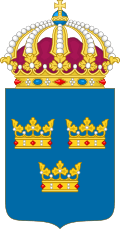

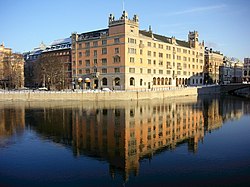
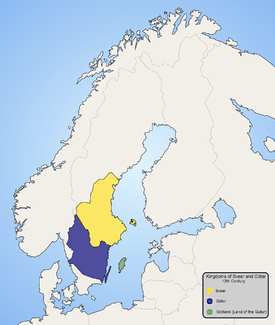
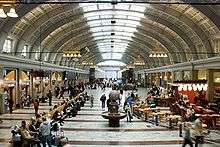
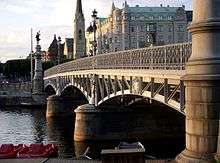
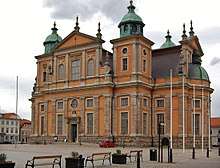
.svg.png)
